

25 Best Motivation Letter Example Templates
The key to convincing potential employers that you are a good candidate is to write a motivational letter. Motivational letters are one of the keys to impressing potential employers. This is different from a cover letter and can be more effective to showcase your years of experience by quantifying your previous accomplishments.
Below we have 25 motivation letter example templates for you to put together a single-page letter unique to you and help you land that dream job.
Sample Letter Template for Inserting Your Body Paragraphs (Body Paragraphs Below)
Using the free template below, the first paragraph should introduce why you are writing to this employer, who you are, and include a summary of your academic institutions and work experience. In the second paragraph, talk about your professional experience, relevant skills, and highlight your value to the company by aligning your skills and experiences with the job posting. The third paragraph should ask for the job interview and include your contact information so that the hiring manager can reach you.
Tailor the following motivation letter to your needs:
[Your Name] [Street Address] [City, State Zip Code] [Telephone Number] [Email Address]
[Hiring Manager Name] [Title] [Company Name] [Street Address] [City, State Zip Code]
Dear [Hiring Manager]:
My name is [Name], and I am writing to express my interest in applying for the [position] at [Company Name]. I have been working toward the goal of having a career in the [industry] industry with [Company Name] and helping it attain its goals of [researched company goals]. My [credential] from [University Name] gives me an edge that can benefit [Company Name].
[Insert your body paragraph(s) here.]
My resume is attached. If you have any questions or if you would like to schedule an interview, please call me at [phone]. I look forward to meeting you to talk further about employment opportunities at [Company Name].
Sincerely, Signature (if a hardcopy letter) [Your Printed Name] [LinkedIn Page, if you have one] [Facebook Page, if it will help you get the job]
25 Best Motivation Letter Example Template Body Paragraphs
Here are 25 sample body paragraphs to plug into the template to create your own letter for that potential job at your dream company.
1. What drew me to [Company Name] was your company vision, [company vision/slogan]. I have demonstrated these values through my work at [Company Name] by always being [quality] and taking the time to [quality]. [Quality] and [quality] are also very important to me, both professionally and personally.
I have [relevant experience] that has catapulted me into learning other aspects of [industry], such as [aspect] and [aspect]. With this well-rounded perspective of [industry], I believe I am the perfect candidate for this position. I have the necessary skills and experience to get you results while keeping your core values at the forefront of everything I do.
2. As you will see by my job application, I have vast experience in [industry], and I’ve always prioritized [quality] and [quality] to ensure a great first impression for every customer. While at [previous Company Name], I developed skills in customer service, sales, and shipping and receiving.
My contributions to the changes in our packaging department saved the company [$number], and our staff appreciated the new [packaging feature]. I believe my strong educational background and extensive experience in the field will be an asset to [Company Name]. I have always been passionate about [industry], and I know that my love of the industry will make my transition into your team very smooth.
3. In your job description for the [position], you listed [quality] as being a priority at [Company Name]. I have [years] of experience managing the [department] where [quality] was made a priority due to changes I implemented in my first year. I have worked in [industry] for [years], and I was impressed by your company news about [quality] being improved across all of your locations. With my extensive experience and a solid background in executing [previously mentioned priority goal], I feel my skills would be a welcome addition to the [department] at [Company Name].
4. Having previously held a [position] and experience in a [field], I understand how challenging it can be to maintain relevance with the rising value of currency and inflation in the [field] market without breaking the budget. I know that [Company Name]’s current focus is to improve [quality], and I’m happy to report that at [current Company Name], I was part of a team that did just that.
In one short [timeline], I led our team to increase [goal] by [number]%, and decrease [goal] by [number]%. The results gave [Company Name] the opportunity to expand [division] by [number]%. Leading my team through this transition allowed me to support all my team members to achieve incredible results. I’m certain I could be a huge benefit to your business.
5. As a master’s degree holder in [industry] with [years] of proven experience in managing both [department] and [department] effectively and efficiently, I am well-prepared for your position. Professionally, I am very organized, calm, and patient with excellent [industry] skills. When [Company Name] experienced hardship with [project], my team and I were able to provide comprehensive solutions that [Company Name] could implement quickly to avoid any loss whatsoever.
In addition to providing quality service to [clients], I have the leadership skills needed to motivate other employees to perform above the industry standard. My team members have always described me as approachable, and results-driven, and I’m proud to say I was awarded [award] for my role at [Company Name]. I would love to bring my incredible expertise to your organization, to plan what we can achieve together.
6. As an [position] at [Company Name], I am responsible for evaluating the [specific measure] of up to [number] [clients]. I am also responsible for developing a rotational system to manage the care of [clients] and coordinate the workforce. I have been recognized as an ambitious, reliable, and dedicated individual who works independently.
Furthermore, I realized and implemented [field] duties I learned in school when I worked in a [position] at [previous employer] for [years]. The [employer]’s management commended my handling of difficult situations with [clients] while I worked there. All of this, along with my relevant education, makes me an ideal candidate for this role.
7. The job position for [position] that you have advertised matches well with the skills that I have acquired during my time at [Company Name]. My areas of expertise and passions are [industry] analysis, project management, and research. In addition to being my passions, these skills are the foundation for any project management professional.
As a financial manager who excels in data analysis, I understand where the company should be focusing its efforts. My experience and deep skillset will launch your company forward into the next decade.
8. I see from your posting that you’re looking for a [position] with experience in [field] maintenance, which happens to be one of my primary strengths. As a [position] at [Company Name], I steered full upgrades to our [task] over [timeline], resulting in an average increase of [number]% in [measurable goal], as well as a decrease of [number]% in [measurable goal]. As a result, productivity and employee satisfaction improved dramatically across the board. Employees found themselves eager to use the new system, and productivity increased by [number]%.
Additionally, I have developed my knowledge of hardware and software issues on [software] as well as [software] at [Company Name]. In addition to my experience level with advanced technical abilities, my proven ability to troubleshoot and resolve problems, and my excellent interpersonal skills, I am confident that I could be a valuable team member at [Company Name].
9. My role as a [position] at [Company Name] is to ensure fluid communication between [department] and [department], including all parties involved. I have doubled the [quantifier] at all [company-organized functions] by implementing new [industry] tactics over the past year. My degree in [subject] also places me in an ideal position to bring forward leadership skills to motivate and encourage all employees.
I have a track record of reliable reporting and a self-reflection tool I use with myself and my employees to drive results to the highest level possible. Employees become motivated to work together as they know I am receptive to all feedback. My passion for hard work and solid results make me the best candidate for your job opening at [Company Name].
10. At [Company Name], I managed a team of [number] people, and my main priority was always based on their safety and security. In contrast to other [positions], I make sure everyone knows their responsibilities when they are due and when they need to make changes, all the while keeping safety in mind. This is done using the system that I have used for [years] throughout that works for me. We conduct a safety meeting every day before anyone lifts a tool, and every [area] is viewable at any time. Every project is then executed on time and on budget, and we can clearly see when we have succeeded and where we need to improve. I think your company would find that I am a good fit for this position.
11. I’ve spent [years] managing [departmental budgets] for a [number]-person company, so I could plan a [frequency] project budget or draft an inter-office budget in my sleep. My career goals include consulting with executives to determine their financial strategies based on their experience.
My skills speak for themselves, but it’s that personal touch that each executive will find invaluable as they watch their investments compound. I take the time to research every client I work for and get to the root of their motivation for maximum results. My experience as a result-oriented professional makes me the right candidate for this position.
12. It was exciting to see that there was an opening in [department] with [Company Name] as your involvement with [other Company Name] has been meaningful to me for a long time. As a result, this job is my best fit since it brings together my experience with [department] and [other Company Name]. This would be a great way for me to integrate myself into your team and help your company launch through your next steps to reach your ambitious goal of [goal].
With my team building and management experience, together with my ability to troubleshoot this process, I believe I would prove invaluable to [Company Name]. At [previous role], I ensured a successful launch of merging both parties, which had a profound effect on both sides. You can count on me to deliver the same caliber of results to your organization.
13. As a longtime admirer of [Company Name]’s success, it was a pleasure to see your job opening. In light of my experience decreasing [goal] by [number]% for [Company Name] while reducing [goal] by nearly [number]% and boosting [goal], I believe I can be of assistance in [Company Name]’s current market challenges. As your company is about to embark on this new chapter, and since I’ve just led a team through a similar project, I think setting up an interview would be beneficial.
14. Ideally, this position will enable me to use my experience gained while holding [position] with [Company Name]. As such, I performed the [duty] at the [location] in all areas of the [department] and the [department]. The experience I gained working in [industry] further prepared me to progress in [industry].
I have a great deal of transferable experience, specifically in [area] and [area]. My objective is to gain a broad understanding of [area], [area], and [area]. Given the opportunity to interview with you, I believe I will make a great first impression on you and your management team.
15. As a [role] at [Company Name], I am in charge of analyzing the [specific measurement] of up to [number] [clients] as well as developing a systematic method for coordinating the care of [clients]. Known for my tenacity, reliability, and dedication, I can work independently. Those clients had a better chance at satisfaction with me leading the team in [department].
When I held a [position] at [previous employer] for [years], I used what I learned in school to fulfill [field] duties. While I worked there, [employer’s management] recognized my ability to resolve difficult scenarios with [clients]. My relevant education, along with my professional experience, makes me an ideal candidate for the role.
16. I have [years] of experience in this part of the business and I understand the communication skills required to perform this job effectively. I am confident that my exposure and knowledge will be an asset to your company. My experience has taught me that teamwork is of the utmost importance. I believe that strong relationships with all the departments in the organization take the company toward success.
I have taught myself to reach out and build relationships with all facets of the organization. I am passionate about my work, and I am confident you will find me a perfect fit for your business.
17. My experience includes leading multi-disciplinary teams and providing actionable solutions through [field] reports, overall campaign effectiveness, analysis, and insights. At [Company Name], I have been successful at increasing [goal] from [number] to number] in [timeframe]. My competitive nature allows me to handle complex situations both strategically and tactically.
With my knowledge of [industry], I managed to achieve [goal for Company Name]. You provide applicants with a vast array of career and growth opportunities, and I would like to join your company because you offer excellent career and growth opportunities. I believe that I am your best chance at hiring someone who will work hard to acquire those opportunities aggressively and with great enthusiasm.
18. I am a brilliant professional [position] who has been consistently praised as a trustworthy leader by my colleagues. Throughout several my career, I have developed proven [skill], [skill], and [skill], which I hope to leverage within the [department] of your company. The first thing I think about before tackling any project is “How can I improve this process to make it safer, and more efficient?” I am always looking for better ways to accomplish company goals. With my vast education and wide-ranging experience, I believe I am the ultimate contender for this position.
19. When it comes to handling and manipulating [product], I am known for my attention to detail and precision. Also, I am proficient in communicating between various groups, including designers, producers, quality assurance personnel, and warehouse personnel.
Your healthcare work appeals to me most about your company. As an employee of [Company Name], I learned the requirements of working in a federally-regulated environment and maintaining the strictest adherence to environmental protection and health regulations. Furthermore, I am committed to setting the latest industry trends and best practices to ensure that my team and I are bringing the latest standards to the warehouse floor. The best thing about having me on your team is that you won’t have to worry about a thing.
20. I worked for a leading [Company Name] for ten years after obtaining a degree from [University]. Several [industry] developments were delivered, and business was good. Along with many other industry professionals, I was laid off during the recession. My new career began with [Company Name] as a leading consultant, achieving a [number]% [goal] for its [project]. Based on this success, my CEO offered me a promotion to my current position [position] for the newly launched [project] of [Company Name].
This high-profile position entails overseeing a team of [number of] [industry] consultants, [industry] engineers, and support staff. Because of my industry knowledge and contacts, I have been able to reduce [field] costs by [number]% every year. In addition to the growth and occupancy goals, I overshot my vacancy turnover goals and resident satisfaction rates as well. Since these results can be reproduced for [Company Name], I believe I would be a good leader to bring a successful future to your department.
21. I’ve had several responsibilities and accomplishments in my previous position at [Company Name], making me an ideal candidate for [position] at [Company Name]. Using a similar format to [Company Name], I wrote plans for [project] at [Company Name], and a number of locations have now adopted it. Furthermore, my [percent] success at [project] and [project] in [industry] are among the best in the state, and I am sure I can produce similar results at [Company Name].
My dream would be to acquire the position at [Company Name]. Your company’s values have always impressed me. I was initially encouraged to become a [position] by several members of [Company Name]. Although I love [task] dearly, there is no other business that would make me as happy to work for as [Company Name]. Should I inherit this position, I am confident that I would be a valuable asset to the team.
22. In my professional career [position], I have consistently been praised by my colleagues as a superior leader. My career has enabled me to develop [skills], [skills], and [skills] that I hope to leverage within your company’s [department]. My successes with [project] over the last [number] years were directly responsible for an increase of [number]% in sales for [Company Name]. In addition, I take the health and safety of my staff very seriously. Before every project, I plan ways to make it efficient, safer, and more cost-effective. Aiming for greater success for the company is my constant goal. Given my extensive education and a variety of experiences, I am the most qualified candidate for this particular role.
23. I am well-suited for this position as a result of my master’s degree and my graduate studies. To complete it, a great deal of independent research was required, necessitating initiative, motivation, and an extensive set of skills. The knowledge of the [industry] was essential for one course, [insert course]. I found this subject to be very stimulating. It prepared me well to begin my career with [Company Name].
My [industry] skills are proficient and precise, and I have a keen eye for detail, so I would be very grateful if I were able to prove myself in this position. My enthusiasm and determination will help me guarantee success in this role immediately.
24. It is my pleasure to have extensive knowledge and experience with multiple applications and processes, including but not limited to [software], [software], [software], [software], and [software]. Throughout my career as an analyst, I acquired skills such as [skill] and [skill], and I approach analytics with a passionate and curious outlook. On my website, you can read several client reviews that demonstrate my ability to spot anomalies and provide solutions to remediate them.
As a self-employed [position], I was not only responsible for delivering on promises to clients but also solely responsible for managing multiple accounts and communicating with any clients. I am confident that these communication skills will help me in this role, which requires good time management and prioritizing skills, along with the ability to communicate findings clearly and concisely.
Despite enjoying the flexibility that comes with working for myself, I am ready to move into a full-time position with a company like [Company Name]. As a team member, I am eager to have the opportunity to collaborate with both my colleagues and clients. Both technical and non-technical team members can benefit from my strong research abilities and presentation skills. As an individual, I am well organized, am open to constructive criticism, and am driven to surpass everyone’s expectations. In my work, I strive for clarity and excellence, which are principles aligned with the company’s core values, which makes me a confident candidate for success on [Company Name]’s team.
25. [Publication] published an article about the opening of your company’s branch in my area, and I read it with great enthusiasm. Congratulations on your new business venture, as well as your pre-launch sale of $[amount]. When I discovered that [Company Name] was hiring, I knew I had to apply.
I have long desired to find a company where I feel like I can make an impact even while working in a [position] in [industry]. My training and knowledge make this the perfect opportunity for me to be a part of your team. Having been vital in the successful launch of [product] at [Company Name], I feel my passion for this [industry] and experience with [field] places me at the top for suitable applicants.
In addition to your letter, you will want to include your resume. Remember: hiring managers read many resumes. If you’re applying for the job of your dreams, as a starting point, consider how quickly your resume could be skimmed by a reader. You want to be direct, assertive, and keep it succinct. Always consider the following:
- Keep your letter to a simple, clean, single page.
- Hook them with the first line.
- Triple check for grammar and spelling mistakes.
- Research the company you are applying to.
- Check the job listing carefully for key requirements and align those with your accomplishments – quantifiable results are what employers are looking for!
- Let your personality shine tough!
For recent graduates with no work experience, it can be the best way to demonstrate your relevant skills by showing specific skills you’ve acquired in school or through volunteering. I hope these examples of professional cover letter samples help you draft your winning letter.
Good luck. You can do this!
Motivational Letter Writing Guide + Examples for 2024

You’re about to apply for the job opportunity of your dreams.
You’ve worked hard, and you can’t wait to take the next step in your career.
All that’s left for you to do is write a motivational letter.
But writing a motivational letter can be nerve-wracking.
Two hours and three coffees in, you’ve scrolled through your Facebook newsfeed (twice), watched one episode of the last season of Game of Thrones, sent angry tweets to its creators, and donated for the knee surgery of two dogs.
You go back to your open Word doc, and all you’ve managed to write is, “This program seems like fun” or “I’ll totally be a great fit for your organization.”
Don’t worry! We’re here to help.
In this article, we’re going to cover:
- How to Write a Motivational Letter, Step-by-Step
- A Great Example of a Motivational Letter
- Useful Motivational Letter Tips
What Is a Motivational Letter?
A motivational letter, sometimes also called a letter of motivation, is a formal letter that you might have to submit when applying for an educational program or a job. Its goal is to show the hiring manager or admissions officer why you’re the perfect candidate for the position.
Motivational letters are typically submitted alongside your CV or resume . Unlike a cover letter, which gives practical examples of how your skills and experience match the opening, a motivational letter focuses more on your personality, interests, and motivation to apply.
When Do You Need a Motivational Letter?
A motivational letter is usually required when an organization wants to gauge your enthusiasm, cultural fit, and motivations for a particular opportunity.
There are a few situations when you might need to submit a motivational letter, such as:
- You’re applying for an educational program.
- You’re applying to work at a non-profit organization or mission-driven company.
- You’re applying for an internship in a competitive field.
- You’re applying for a volunteer position at a charity or non-government organization.
- You’re applying for a grant, fellowship, or some sort of scholarship .
No matter the situation, a motivational letter serves to express your distinct driving forces and convey your enthusiasm for that specific role, program, or opportunity. That’s why, done right, a motivational letter can convince the reader to go through your application in detail.
However, if the specific position doesn’t explicitly require a motivational letter or other written statement, you might be better off learning how to write a cover letter instead. Cover letters can be a great addition to your application and help you stand out from other candidates who are only relying on their resumes.

How to Write a Motivational Letter
Now that you know what a motivational letter is, it’s time to write your own.
Just follow the steps we’ve outlined, and you’ll be done in no time:
#1. Address Your Letter Appropriately
Your motivational letter should include a header with all the necessary contact details.
For starters, this means you should include your contact information , such as your full name, email address, phone number, and any other details that might be necessary for your application.
Additionally, you should include your intended audience’s contact details. Depending on where and what you’re applying for, this might be either a hiring manager or an admissions officer.
To establish a connection with the reader, include a personalized greeting instead of the generic “To Whom It May Concern.” To do that, you have to find out who the hiring manager or admissions officer is.
Start by doing a bit of research. Review the job listing, the program’s official page, or the application instructions. If you can’t find their name there, check the organization’s website and look for a staff directory.
Once you have their name, address your motivational letter professionally . We recommend using an identifier followed by their last name. But if you’re not sure about their title or gender, you can just use their full name, too. For example:
- Dear Mr. Smith,
- Dear Dr. Singh,
- Dear Cameron Smith,
Just avoid informal greetings like "Hey, John!" – your motivational letter is still meant to be a formal document.
#2. Stick to the Program Requirements
Writing a captivating motivational letter is all about showing the hiring manager or admissions officer how you meet the requirements for the position.
To help get the ball rolling as you start drafting your motivational letter, ask yourself:
- What kind of applicants are usually admitted to the program?
- How do you fulfill the requirements?
First, you need to know the exact program requirements and explain how your background and strengths align with the outlined criteria.
Comb through the details the organization has provided about the ideal skills, experiences, qualifications, or personal qualities they’re looking for in a candidate. Maybe they want someone proficient in data analysis , or they’re prioritizing candidates who are passionate about the industry.
Just remember – you don’t have to highlight how you meet all the listed requirements if your application already includes a detailed academic CV . Just identify the top three to five requirements and give concrete examples of how you meet each.
Here’s an example:
Requirement: Minimum 2 years of volunteer experience
“I was a medical volunteer in Namibia for three years. It’s one of my most fulfilling adventures and transformative experiences so far since I am passionate about helping others. I believe it broadened my horizons and made me more resilient.”
#3. Align with Their Values
Your motivational letter should explain what drives you and show the reader how you share their organization’s values.
Take time to thoroughly research the organization , its culture, objectives, and driving forces. Find what resonates with your own beliefs and goals and mention it in your motivational letter.
But don’t just randomly sprinkle keywords into your letter. Instead, thoughtfully use your passion to build a narrative that shows how your values align with the institution’s mission.
Be sure to give concrete examples. For instance, if the company values sustainability, you might want to share an anecdotal example, such as:
Values: Sustainability, Climate Action, Nature Conservation
I have a deep passion for nature conservation, and I have volunteered extensively with environmental organizations, especially in restoring local wetland habitats. I also practice eco-friendly habits in my professional life by advocating for reducing workplace waste and single-use plastics.
#4. Express Genuine Interest
Above all, your motivational letter should demonstrate that you really want to be there.
That said, there is a fine line between pleading and showing intelligent interest while also selling yourself. Generic statements can come across as insincere and unmotivated. Instead, write about what really attracted you to the opportunity.
Be as specific as possible and express your passion without necessarily begging them for a chance. For example:
- I would love to live in Aberdeen because I’m fascinated by Highlander culture, and I’m excited to dive into the city’s rich cultural heritage and vibrant community dedicated to the arts, music, and preserving Scottish traditions.
- It is my dream to be part of the Environmental Science Master's program because of its cutting-edge research in sustainable energy solutions and marine conservation efforts, which align with my passion for protecting our planet's ecosystems.
Specific examples and details show you've invested time learning about the organization, which helps your genuine passion shine through your motivational letter.
#5. Personalize It
While showcasing how you meet requirements is crucial, don't be afraid to let some of your personality and voice shine through.
Use descriptive adjectives to paint a fuller picture of who you are beyond just your credentials. Are you an endlessly curious, lifelong learner? A creative problem-solver? Passionate about how technological advancements can be used to increase sustainability?
Let your distinct character and values shine through to make your motivational letter more memorable and help differentiate you from other applicants. This can convey important soft skills and give the reader a glimpse of the person behind the qualifications.
Just make sure you’re still presenting a polished bit of personality and keeping it relevant to the opportunity. For example, if you’re applying for an MA in mathematics, don’t mention your passion for historical re-enactment.
Are you applying for an academic program? Learn how to write an academic personal statement here.
#6. Don’t Just Recap Your CV
Using your motivational letter to simply summarize your CV is a wasted opportunity. If the application requires a motivational letter, they’re looking to get to know you beyond the required stats and qualifications.
The person reading your motivational letter is looking for the context around your motivations, passions, and aspirations. So, instead of just listing credentials, expand on the driving forces behind your experiences and decisions.
If you’re applying for a master's program, for example, mention your relevant undergraduate coursework, but also explain what sparked your interest in this specialization and why this path is personally meaningful. So, if you’re a History undergrad, elaborate on how volunteering at the archaeology museum made you pursue a graduate degree in Museum Studies and Curatorship.
Here’s a practical example of how that might look:
As a History undergraduate, my passion for preserving and sharing our cultural narratives was sparked by a semester-long museum internship. Working alongside curators as they brought ancient artifacts and stories to life through compelling exhibits opened my eyes to the vital role museums play in education and connecting communities to their roots.
This experience solidified my drive to pursue museum studies at the graduate level, where I can develop professional expertise in responsible collection stewardship, thoughtful exhibition development, and engaging public programming that keeps our shared histories vibrant and accessible for all.
Getting your documents ready for that application? Learn how to write a resume with our detailed guide.
#7. Convey Your Ambitions
Your motivational letter should express your ambitions and aspirations just as much as your relevant achievements . Admissions committees and employers who ask for motivational letters want to clearly understand both your goals and how this opportunity aligns with them.
Share your vision for how you plan to apply the knowledge, essential skills, or experience you'll gain. If it's a job, explain how it will prepare you for further career growth and impact in that field. For an academic program, discuss how you aim to contribute to cutting-edge research or become a leader and mentor.
Don't be afraid to think big - motivated candidates often have big goals of driving innovation, making a difference, or pushing boundaries in their discipline. Just make sure your aspirations are realistic and show that you have a plan and are truly invested in this path for the long term.
Here’s an example of how you can convey your ambitions in your motivational letter:
My long-term goal is to become a leader in sustainable urban design and planning that seamlessly integrates green infrastructure into the built environment. This master's program will equip me with the interdisciplinary skills to develop eco-friendly architectural solutions and climate-resilient city policies that prioritize environmental conservation alongside economic growth and social equity.
#8. Don’t Lie
One of the biggest mistakes you could make while writing your motivational letter is lying.
If you write anything remotely false, the reader will likely sense it. When you lie, you’re likely to unconsciously exaggerate your feelings and ideas. If you tell a fake story or inflate your excitement or achievements, you won’t get anywhere.
Your dishonesty is likely to be exposed and severely damage your credibility, leading to an immediate rejection.
Honesty and integrity are essential to writing an effective motivational letter. The goal of this document is to truly reflect who you are, why you’re the best match for this opportunity, and what you hope to achieve.
Don’t worry if you think your life so far just isn’t impressive enough to write a captivating story. No matter where you’re coming from, you can show the reader your unique perspective, personal growth, and unwavering determination to pursue your passions.
#9. Use a Motivational Letter Template
If you want your motivational letter to make a striking first impression, presentation matters.
A basic black-and-white document from a text editor will hardly stand out. Instead, try one of our professionally designed motivational letter templates for an attention-grabbing solution!
Novoresume offers modern, eye-catching templates that can give your motivational letter a polished look. You can even use the resume builder to match your motivational letter to one of our sleek resume templates for a coherent application.
Save precious time on formatting and create a visually flawless application in no time!

How to Structure a Motivational Letter
You’ve got the gist of how to write a motivational letter down, but it’s just as important to know how to structure it.
If your motivational letter is a messy, haphazard series of unrelated paragraphs, it simply won’t make the cut. You need your motivational letter to tell a coherent story, and this is where the structure comes in.
The whole process will probably require a few drafts until you get to the perfect, polished motivational letter. You might have to move around paragraphs or sentences until you have the ideal story that compliments your application, so don’t worry if you don’t get it right the first time.
Let’s look at what each motivational letter looks like and includes:

#1. Contact Details
Start by adding all the relevant contact information at the top of your motivational letter.
Here’s what to include:
- Full Name. Place your first and last name at the top of the page.
- Professional Title. Match your professional title to the specific position you're aiming for. E.g.: if you’re applying for a Ph.D., write “Ph.D. candidate”.
- Email Address. Include a professional and straightforward email address. We recommend sticking to something that combines your first and last name.
- Phone Number. Include your phone number and add the dialing code in front if you’re applying overseas.
- Location. Adding your city and state/country is more than enough.
- Relevant Links. Optionally, you can include links to any relevant websites or social media profiles, such as a portfolio, a blog, a LinkedIn profile , etc.
Then, add the contact information of the admissions officer or hiring manager reading your motivational letter, such as:
- Organization’s Name. Start with the name of the organization to which you're sending your application.
- Recipient’s Name. If possible, find the name of the exact person who's going to be viewing your application, such as the hiring manager or the admissions officer for the department you're interested in. Check the organization’s website to get a head start.
- Recipient’s Title. Always address the reader professionally. For example, if they’re a professor or doctor in their field, use the appropriate identifier.
- Location. Provide the exact address of the organization you’re applying to. Include the city, state, country, and street number, and even specify the building if necessary.
#2. Introduction
Begin your motivational letter with a strong introduction.
The first few sentences need to be attention-grabbing – do this through a short, engaging pitch about yourself and why you are applying.
Here’s what you can include:
- A summary of who you are and what you do.
- Details about what you’re applying for and where.
- A prelude to the bulk of your motivational letter.
Remember - this part only needs to include the general reasons behind your application, since you’ll have the opportunity to make a deep dive later on in the body of your motivational letter.
Let’s look at an example of what your introduction could look like:
Dear Dr. Octavio,
My name is Jane Doe, and I would like to express my interest in applying for the Ph.D. Robotics program at Columbia University. I’ve always dreamed of becoming a robotics engineer and contributing to advancement in the field, and I believe that a Ph.D. in Robotics from this university would set me miles ahead of reaching my goal.
The body of your motivational letter is where you get to really sell yourself.
It’s also where the bulk of your text is going to be, so it determines your motivational letter as a whole.
There are two things you should keep in mind when writing this section of your motivational letter: the paragraph structure and the paragraph contents.
Generally, there are two main paragraph-based structures for your motivational letter.
First is the classic, three-main-paragraph structure, where each paragraph accounts for your introduction, body, and conclusion. If you’re using a storytelling approach for your motivational letter, we recommend sticking to this one.
However, if you want to be more factual and to the point, we recommend trying the seven-paragraph structure. It divides the main body of your motivational letter into smaller paragraphs according to your main points, where each discusses a specific achievement, experience, or aspiration.
Use the body of your motivational letter to mention the stories behind your achievements, essential skills , and passion for whatever you’re applying for.
This is the right place to be as detailed and factual as possible. Give concrete examples of what motivated you to apply for this position, and show how that directly relates to what the organization is looking for in a candidate.
Here are some sentences you can paraphrase and use to help you write the body of your motivational letter:
- My passion for [field] started when [experience] .
- I want to [join this organization] because [ motivation] .
- I have been part of [relevant organization or field] for [amount of time] . It’s the best thing for me because [reason] .
- I remember once when I [experience] , which made me realize that I [gained interest in the specific field] .
- [Organization or program] resonates with me because [specific reason] .
- What distinguishes me from my peers is [something you’re proud of] .
Let’s look at a brief example of how this is put into practice.
I developed my passion for digital marketing during my internship at XYZ Inc. Working for a small startup allowed me to gain surface-level experience in most digital marketing channels. Now, I would like to deep-dive and gain advanced know-how by attending the Buffalo College Marketing program.
#4. Conclusion
After finishing the body of your motivational letter, it’s time to wrap it up and send it in.
Use this section to briefly summarize your main points and remind the reader why you’d be a great fit for the organization or program you’re interested in.
Then, mention your overarching career goal and how that aligns with their organization’s mission.
Finally, thank the reader for their time and sign off on your motivational letter. Here’s an example:
Therefore, I believe that my strong academic foundation in environmental studies and hands-on fieldwork experience are qualifications that position me to make outstanding contributions to your master's program. I believe that the knowledge I gain in the Sustainability and International Relations program will play a pivotal role in my mission of shaping innovative policies and scientific solutions to combat climate change and protect our planet's biodiversity for future generations.
Thank you for considering my application. I look forward to the opportunity to join UCLA in the fall semester.
George Maxton
How to Format a Motivational Letter
Always review your motivation letter carefully and stick to any stated requirements or guidelines for your application.
Organizations will sometimes include formatting specifications, like word count or page limits, or even questions they want you to answer in your motivational letter.
If you’re writing a motivational letter for an academic program, you can usually find this information on the admissions requirements webpage or within the provided application materials.
For job applications, these details are usually listed on the job ad or in the company's job application portal.
Always follow these rules exactly as stated. Going off script could get your application immediately rejected since it shows you’re either not attentive or you’re not taking the opportunity seriously.
If, on the other hand, there aren’t any guidelines for your motivational letter, we recommend you follow these tips:
- Keep your motivational letter one page long.
- Use a clear structure with concise paragraphs to make your letter easy to skim.
- Choose a professional font like Lora or Roboto and make sure it’s sized 11-12 pt.
- Set your page margins to one inch on all sides so your page doesn’t look too cluttered or too empty.
- Include the date you wrote your motivational letter for an extra professional touch.
- Use powerful words and action verbs (“designed” and “conceptualized”) instead of cliched phrases (“helped with” and “managed”).
- Smoothly connect your thoughts through transition words.
- Proofread carefully for any spelling or grammatical errors.
- Include a professional closing line like "Sincerely" at the end of your text.
- Print your motivational letter out and sign it, or send it as a PDF to preserve your formatting.

Motivational Letter Example
Let’s look at an example of a great motivational letter for a Ph.D. program at Harvard University and go through just what this candidate does right:

The candidate’s letter to Harvard University’s Department of Political Science starts by addressing the person in charge of admissions for the Ph.D. program they’re interested in.
The general requirements for the Political Science program are:
- Being research inclined
- Having a demonstrated passion for politics
- Showing above-average performance during undergraduate studies
The values of the university they’re applying to are integrity, education, respect, and accountability.
The candidate’s motivational letter is neatly divided into a total of five paragraphs, of which three make up the body of the text.
Here’s how they highlight their motivation:
- They know the history of the university and share the same values.
- They’re genuinely excited and passionate about the program and the school.
- They show what their qualifications are and how they’ll be a great fit for the program.
- They explain what they hope to achieve if they get the opportunity to study at Harvard.
Essentially, the candidate has listed all their qualifications through a personal story. After reading this letter, the admissions officer will feel like they know the candidate adequately, especially since they have communicated who they are by highlighting how they match everything the Ph.D. program is looking for in an applicant.
Need more inspiration? Check out our 60+ cover letter examples for different professions.
Key Takeaways
You’ve made it to the end of our guide!
Now, you know everything there is to know about motivational letters. We’re confident you’re a shoo-in for that position you have your sights set on!
But before we go, let’s quickly sum up what we’ve covered so far:
- A motivational letter is a formal document that’s usually required when applying for university admissions, a non-profit organization, or a volunteer position.
- Motivational letters are different from cover letters since they focus more on your interests, passions, and ambitions than on your skills and achievements.
- Generally, there are two ways to structure your motivational letter, depending on whether you want to tell a story or factually go through all the points that make you an ideal candidate.
- The introduction of your motivational letter should be brief and immediately grab the reader’s attention. Use it to tell them who you are and why you’re interested in applying for the specific opportunity.
- Always do your research on the specific program or organization. This can help you show genuine interest and convey your aspirations for the future in this field.
- Make your motivational letter stand out by using one of Novorésumé’s templates and giving the admissions officer or hiring manager a gorgeous first impression.

To provide a safer experience, the best content and great communication, we use cookies. Learn how we use them for non-authenticated users.
- Career Blog
Write an Irresistible Motivation Letter: Tips and Examples

When applying for a job or a university program, the motivation letter is your opportunity to make a great first impression. It is your chance to showcase your skills, achievements, and personality to the employer or admission committee.
Overview of Motivation Letter
A motivation letter, also called a cover letter, is a formal letter that accompanies your resume or application. It is usually one page in length and explains why you are applying for the position, how you meet the requirements, and what you can contribute to the organization or institution.
Importance of Motivation Letter
Your motivation letter is more than just a formality; it can make or break your chances of getting hired or accepted. Many employers and universities use it as a screening tool to evaluate your communication skills, motivation, and fit for the position or program. A great motivation letter can set you apart from other applicants and make you stand out as a top candidate.
Research and Preparation
When crafting an irresistible motivation letter, research and preparation are key. To impress your potential employer, you need to show that you understand both the target audience and the organization you’re applying to. Here are some steps you can take to make sure you hit the mark.
A. Identify the Target Audience
Your motivation letter should be tailored to the specific person or people who will be reading it. Who are they, and what do they value? Depending on the industry, the answer to this question may vary. For example, if you’re applying for a job in a creative field, your potential employer may be looking for someone with an eye for detail and a unique vision. However, if you’re applying to a corporate position, they may be more interested in someone who can demonstrate leadership and management skills.
When identifying your target audience, take a look at the job description and company website. Look for clues about the organization’s values, goals, and preferred qualifications. This can help you tailor your letter to the reader’s needs and interests.
B. Research the Organization
In addition to understanding your target audience, it’s important to have a deep understanding of the organization you’re applying to. This can help you speak to the specific challenges and opportunities that the company faces, and demonstrate how you can contribute to their goals.
Start by researching the company’s history and mission, as well as their recent news and developments. Learn about the company culture and values, and try to get a sense of what it’s like to work there. You should also research the industry more broadly, and stay updated on relevant trends and news.
C. Highlight Key Skills and Qualities
Finally, your motivation letter should emphasize your key skills and qualities in a way that shows how they relate to the job you’re applying for. Make sure to use specific examples and anecdotes that demonstrate how you’ve put these skills into practice, and explain how they can benefit the organization.
Some key skills and qualities to emphasize might include:
- Leadership and management
- Problem-solving and critical thinking
- Communication and collaboration
- Creativity and innovation
- Industry-specific technical knowledge and expertise
By highlighting these qualities, you can demonstrate that you have what it takes to excel in the role and contribute to the organization’s success. Just make sure to stay concise and focused, and avoid being too general or vague in your descriptions.
Structure of the Motivation Letter
When it comes to writing an irresistible motivation letter, how it is structured can make a significant difference in whether or not it catches the attention of the reader. Here, we will discuss the basic structure of a motivation letter, as well as the key components of each section within it.
A. Basic Structure
The basic structure of a motivation letter should include an introduction, body, and conclusion. These sections are what set it apart from a traditional cover letter or resume.
B. Introduction
The introduction serves as the opening statement of your motivation letter. It should be brief, yet compelling enough to capture the attention of the reader. Consider starting with a personal anecdote, a quote, or a statement that highlights your strengths or interests.
The body of your motivation letter is where you delve deeper into your experiences, skills, and why you are the perfect fit for the position you are applying for. Divide this section into several paragraphs, each one addressing a specific topic or point. Use examples to illustrate your points, and be sure to tailor your language to the specific job requirements and company culture.
D. Conclusion
The conclusion serves as the closing of your motivation letter, and should leave a lasting impression on the reader. Summarize your key points, reiterate your interest in the position, and thank the reader for their time and consideration. Consider ending with a call to action, such as requesting an interview or further discussion.
A well-structured motivation letter can make all the difference in catching the attention of potential employers. The basic structure should include an introduction, body, and conclusion, each section highlighting your skills, experiences, and why you are the best fit for the job. By using examples to illustrate your points, tailoring your language to the specific job requirements, and ending with a compelling call to action, you can write an irresistible motivation letter that will set you apart from the competition.
Dos and Don’ts of Writing a Motivation Letter
When it comes to writing a winning motivation letter, there are several dos and don’ts to keep in mind. Follow these guidelines for best results:
Use active voice: Use active rather than passive voice to convey passion and energy in your writing.
Keep it concise: Keep your letter brief and to the point, highlighting your relevant skills and experience.
Use real-life examples: Include concrete examples of situations where you have demonstrated the skills and qualities relevant to the position you are applying for.
Highlight accomplishments: Focus on your achievements and successes, and use them to demonstrate how you will be an asset to the organization.
B. Don’ts
Don’t use slang or jargon: Keep your language professional and avoid using slang or technical jargon that may be unfamiliar to the reader.
Don’t repeat the resume: Your motivation letter should complement, not repeat, your resume. Avoid duplicating information that is already included in your CV.
Avoid generic statements: Be specific and concrete in your writing, and avoid vague or generic statements that do not add value to your application.
Don’t make demands: Remember that your motivation letter is a sales pitch, not a request. Avoid making any demands or ultimatums, and keep your tone positive and professional.
Tips for Writing an Irresistible Motivation Letter
When it comes to writing a motivation letter, there are certain key tips that can help you make your application stand out. Here are some of the most important things to keep in mind:
A. Address the right person
One of the easiest ways to make a bad impression with your motivation letter is to get the addressee wrong. Before you begin writing your letter, make sure you have the correct name and title of the person who will be reading it. You don’t want to start off on the wrong foot by sending a letter to the wrong person or using the wrong title.
B. Use strong opening sentences
The first few sentences of your motivation letter are crucial, as they are what will grab the reader’s attention and make them want to keep reading. Use powerful language and vivid imagery to make your opening sentence as compelling as possible. You might also consider starting with a bold statement or a question that will pique the reader’s curiosity.
C. Showcase enthusiasm
Enthusiasm is one of the key characteristics that employers look for in potential hires, so it’s important to let your passion and excitement shine through in your motivation letter. Talk about why you are excited about the job or program you are applying for and how it aligns with your personal goals and values. Use concrete examples to illustrate your enthusiasm and make it clear that you are genuinely passionate about this opportunity.
D. Highlight relevant skills and experiences
Your motivation letter should make it clear why you are the best candidate for the job or program you are applying for. One of the best ways to do this is to highlight your relevant skills and experiences. Talk about specific projects you’ve worked on or accomplishments you’ve achieved that demonstrate your abilities and qualifications. You don’t want to just list your skills; you want to show how they have been put into practice.
E. Use positive language
Finally, it’s important to use positive language throughout your motivation letter. Avoid negative phrasing or any language that might come across as defensive or apologetic. Instead, focus on highlighting your strengths and achievements and framing them in a positive light. Use active verbs and confident language to show that you are capable, competent, and ready to take on the challenges ahead.
By following these key tips, you can craft an irresistible motivation letter that will help you stand out from the crowd and land your dream job or program. Good luck!
Common Mistakes to Avoid
When writing a motivation letter, it’s essential to avoid common mistakes that can make your application look unprofessional and reduce your chances of success. Here are some of the most common mistakes you need to avoid:
A. Grammatical errors
Grammatical errors are perhaps the most common mistake made by job applicants when writing a motivation letter. These errors can include misplaced verbs, lack of subject-verb agreement, and run-on sentences. To avoid grammatical errors, it’s best to proofread your letter carefully and consider using a grammar-check tool, such as Grammarly.
B. Spelling mistakes
Spelling mistakes can also make your motivation letter look sloppy and unprofessional. Common spelling mistakes that you need to avoid include homophones, such as “your” and “you’re,” words with multiple spellings, such as “judgment” or “judgement,” and typos resulting from typing errors.
C. Confusing writing style
Your motivation letter should be easy to read and understand. Confusing or convoluted writing style can discourage the recruiter from reading the entire letter. Use clear and concise sentences that get to the point, and consider using bullet points to organize your thoughts.
D. Lack of enthusiasm
Finally, a lack of enthusiasm can make your letter appear bland and uninteresting. Use descriptive words to convey your passion for the job and the company, and provide examples of your achievements and qualifications that demonstrate your enthusiasm for the position you’re applying for.
By avoiding these common mistakes, you can enhance the quality of your motivation letter and increase your chances of success in landing your dream job.
Example of an Irresistible Motivation Letter
As a copywriter and subject matter expert, I can attest that a well-crafted motivation letter can be the key to landing your dream job or securing your desired scholarship. To further illustrate this point, let’s delve into an analysis of a sample motivation letter and why it works so well.
A. Analysis of a Sample Motivation Letter
The sample motivation letter we’ll be analyzing was written by Jane Doe as part of her application for a marketing internship at a leading company. Some key points that make this letter stand out include:
Personalization: Jane takes the time to research the company and its goals, and tailors her letter to show how she can contribute to those goals specifically. This shows that she is genuinely interested in the company and not just blindly applying to any available position.
Clear structure: The letter is well-organized, with an introduction that states her purpose and a body that presents specific examples to back up her claims. The closing paragraph then sums up her strengths and expresses her eagerness to meet and discuss further.
Positive tone: The letter is upbeat and confident without being overly boastful or arrogant. Jane shows that she is passionate about her field and eager to learn more, while still acknowledging that she still has room to grow and improve.
B. Tips on Why the Sample Letter Works
So, what can we learn from Jane’s motivation letter? Here are a few tips to keep in mind when crafting your own:
Do your research: Take the time to read up on the organization you’re applying to and figure out what they’re looking for. Then, customize your letter to show how you can meet those needs specifically.
Be specific: Don’t just make vague claims about your skills or experience. Use concrete examples and data to back up your assertions, whether it’s a successful project you led at a previous job or a relevant course you excelled in.
Keep it upbeat: While it’s important to showcase your qualifications and accomplishments, don’t forget to convey your enthusiasm and passion for the industry or field you’re applying to. Companies want to hire people with energy and drive, so show them that you’re excited to get to work.
The key takeaway from Jane’s letter is that a well-crafted motivation letter can truly set you apart from the competition. By taking the time to personalize your letter, showcase your strengths, and stay positive, you can make a strong case for why you’re the ideal candidate for the job or scholarship you’re after.
Related Articles
- One Page Resume vs Two Page Resume: Complete Guide
- Journeyman Carpenter: Job Description, Salary, and Skills
- Essential Elements of a Strategic Plan: A Guide to Success
- Math Teacher Resume: Sample and How-To Guide for 2023
- Why Is It So Hard to Find a Job? 10 Expert Tips for Success
Rate this article
0 / 5. Reviews: 0
More from ResumeHead

Resume Templates
Resume samples

Create and edit your resume online
Generate compelling resumes with our AI resume builder and secure employment quickly.
Write a cover letter

Cover Letter Examples
Cover Letter Samples

Create and edit your cover letter
Use our user-friendly tool to create the perfect cover letter.
Featured articles
How to Write a Motivation Letter With Examples
- How to Write a Resume in 2024 That Gets Results
- Teamwork Skills on Your Resume: List and Examples
- What Are the Best Colors for Your Resume?
Latests articles
- Top 5 Tricks to Transform Your LinkedIn Profile With ChatGPT
- Using ChatGPT to Prepare for Interviews: Top Tips and Steps
- How to Create an Effective Cover Letter with ChatGPT
- 10 Jobs in High Demand in 2024: Salaries and Expected Growth

Dive Into Expert Guides to Enhance your Resume

Have you ever heard of a motivation letter? It’s a powerful tool to help you snag that dream job and it’s becoming increasingly popular.
Let’s dive into what exactly a motivation letter is, when it’s best to use one, and how to write it. And don’t worry, we’ve got some inspiring examples to share with you too!
Use our online editor to craft the perfect letter
Impress employers with our professional templates and stand out.

What Is a Motivation Letter?
So, what is a motivation letter , you ask? Well, it’s a short letter that explains why you’re the perfect fit for a job. We’re talking just one page here. It’s your chance to highlight your achievements and showcase your interests.
Typically, you’ll attach a motivation letter to your resume when you apply for a job. But that’s not all. You can use it in other situations, like applying to a college or university, an educational program, an internship, or even a volunteer role.
Now, you might be thinking, “Isn’t that what a cover letter is for?” Great question! There are indeed similarities and differences between these two documents. We’ll break it down for you in just a bit.

Craft your letter in 3 simple steps
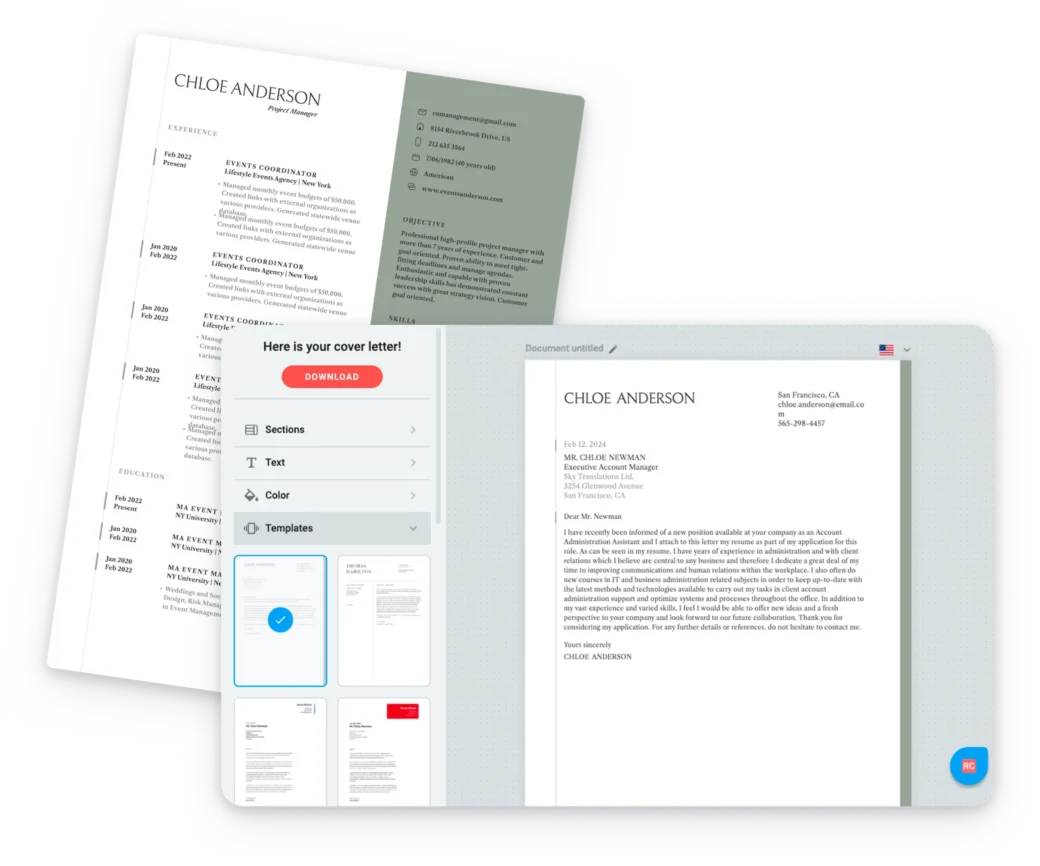
- Select one of our unique cover letter templates
- Write a text tailored to your professional profile
- Download your letter in PDF or TXT format and easily share it online
Motivation Letter vs. Cover Letter
Now, let’s talk about cover letters and motivation letters. They might seem pretty similar at first glance—both are 1 page or less and go along with your resume and application. Their goal? To impress the hiring manager and make them seriously consider your application.
But here’s the scoop: there’s one key difference between these two types of letters.
Cover letters dive into the nitty-gritty, with specific examples of how your education, skills, job experience, and achievements perfectly align with the job requirements. They concentrate on highlighting your work experience.
On the flip side, motivation letters take a broader approach . Instead of focusing on specifics, they showcase your interests, personality traits, and the reasons behind your application. They’re great when you don’t have much relevant experience to share. We’ll dig into this more in the next section.
See? Cover letters and motivation letters each have their own superpower. Let’s discover how to make the most of motivation letters for your dream job!
The best cover letter templates
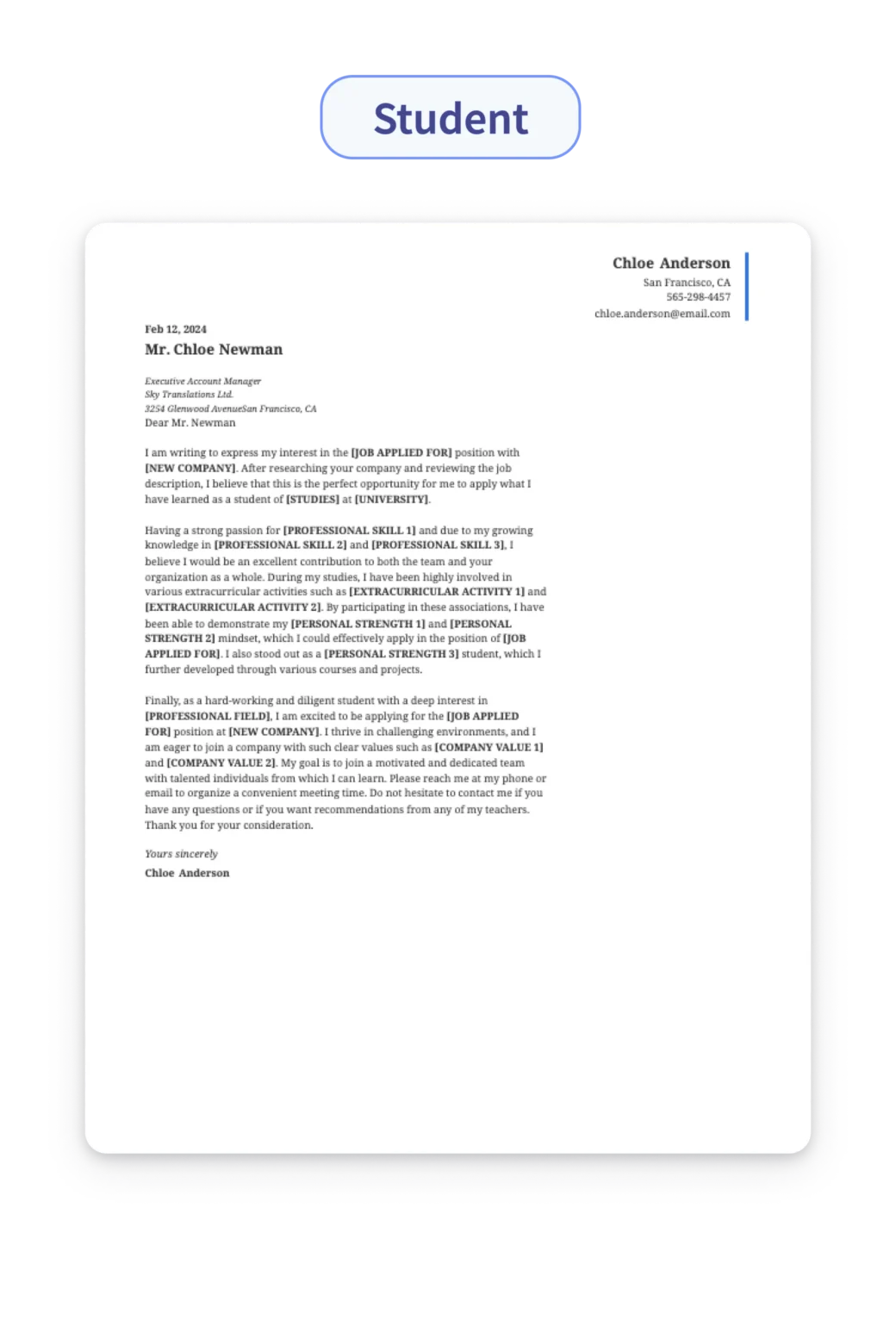
When to Use a Motivation Letter
As mentioned above, if you lack experience directly related to the position you want, a motivation letter can be a real game-changer. It’s perfect for those entry-level roles you’re aiming for.
1. Motivation Letter for University
Now, let’s dive into some specific situations. When it comes to applying to university, your application alone might not fully capture your passion and excitement. That’s where a motivation letter jumps in to save the day.
Use it as a platform to highlight your special connections with the university, why you’ve always dreamed of attending that specific school , or why you’d be an amazing fit for their programs. Show them the real you!
2. Motivation Letter for Job
And when it’s time to land your very first entry-level job , you might not have the work experience to boast about on your resume just yet. But don’t worry! Your enthusiasm and unique qualities can shine through in your motivation letter. It’s all about what makes you stand out from the crowd.
3. Other Times to Use Motivation Letters
Here’s something super cool: motivation letters aren’t limited to just education or employment. They can work their magic for other opportunities too. Just imagine the impact a motivational letter could have on your application for a volunteer position or an internship. It could be a total game-changer.

How to Format a Motivation Letter
The structure of a motivation letter is very important because it helps you present your ideas and showcase your desire to make a real impact in a new company.
In this section, we’ll dive into the key parts of a motivation letter: the introduction, body, and conclusion. But that’s not all! We’re also here to guide you on what to include in each section, so you can create a compelling, well-formed letter.
Introduction and Recipient Information
Starting your motivation letter with a professional salutation is the way to go. It shows that you mean business. Make sure to address the recipient by their name and title if you have that information. It adds a personal touch and shows that you’ve done your homework.
But if you don’t have the recipient’s name, don’t stress. You can use a general salutation like “Dear Sir/Madam” or “To Whom It May Concern.” It’s totally okay and still professional.
Next comes the introduction. It’s all about giving a brief introduction of yourself and stating the purpose of the letter. Are you applying for a job, internship, or scholarship? Let them know! Keep it concise and to the point.
Write a letter to tell why you want the job and what makes you good for it. Split the body into 2 or 3 paragraphs so it’s easy to read.
- Why you want the job : In the first part, tell why you want the job. Say what you like about the company and how the job fits your plans.
- What you can do : In the next part, talk about what you can do. Share things you’ve done before that show you’re right for the job. Use real examples to show your skills.
Finish your motivation letter layout by going over what you said and showing how excited you are about the job .
Let them know you’re ready to talk more and give them a way to contact you. Close your letter with words like “Sincerely” and then put your name.
A well-structured letter, with attention to detail, effectively presents your eagerness and qualifications for the position.

How to Write a Motivation Letter
If you find resume and cover letter writing, a challenge, you might feel that motivation letters are intimidating as well. The good news is, they don’t have to be!
Create a Motivation Letter Template
Now you know how a motivation letter should look. Let’s get into the details.
To know exactly how to write a motivation letter for a job application it’s really important to include all the necessary details. It should be like a regular business letter . Keep it professional and follow the usual format.
Use the steps below to show why you’re the best for the job.
- Use a template : A motivation letter template can help you write better and not miss anything.
- Your address : Put your address at the top or just above the date. Only add your street, city, state, and zip. No need for your name here.
- Date : Write the full date, like “April 6, 2023.”
- Who you’re writing to : Write the person’s title, name, and address. Make sure it’s all correct.
- Greeting : Start with “Dear” and the person’s name or title, like “Dear Mr. Smith.” Use a colon after.
- What to say : Split your letter into short parts. Start by stating the position or program you are interested in, then explain your motivations. Highlight your qualifications, skills, and relevant experiences that make you an ideal candidate. Be specific and provide examples or anecdotes that support your claims.
- End your letter : Finish with words like “Sincerely” or “Thank you.” This shows you’re thankful for their time.
- Sign it : If it’s a paper letter, leave space to sign your name. If it’s an email, you don’t need this space.
Always type your full name on the letter, whether it’s on paper or email. This shows it’s really from you and you agree with what’s written.
If you send other documents with your letter, like a resume, say so in the letter. Write something like “Enclosures: Resume, Application.”
In emails, just say you’ve added attachments below your name or in the letter.
Motivation Letter Writing Tips
You can use the following tips as a checklist to make sure your letter is the best it can be.
- Use the hiring manager’s name : If you don’t know it, look on the company’s website or call them. If you’re not sure about their gender, just use their job title or full name without “Mr.” or “Dr.”
- Don’t just repeat your resume in the letter : Instead, add the things that didn’t fit in your resume.
- Use action verbs : to make your letter lively.
- Include resume keywords . The company might pass both your resume and letter through an applicant tracking system (ATS).
- Don’t sound too eager or make things up : They’ll find out if you’re not honest.
- At the end, include why you’re right for the job and what you hope to learn. Last, ask them to contact you or say you hope to talk soon.
- Check your letter for mistakes : Use tools like Grammarly to help.
Enhance your content with our pre-defined cover letters
Do you need help writing your cover letter? Select the category that corresponds to your professional profile to access our pre-defined texts.
Our suggestions enable you to obtain a compelling letter tailored to your profession quickly and easily.
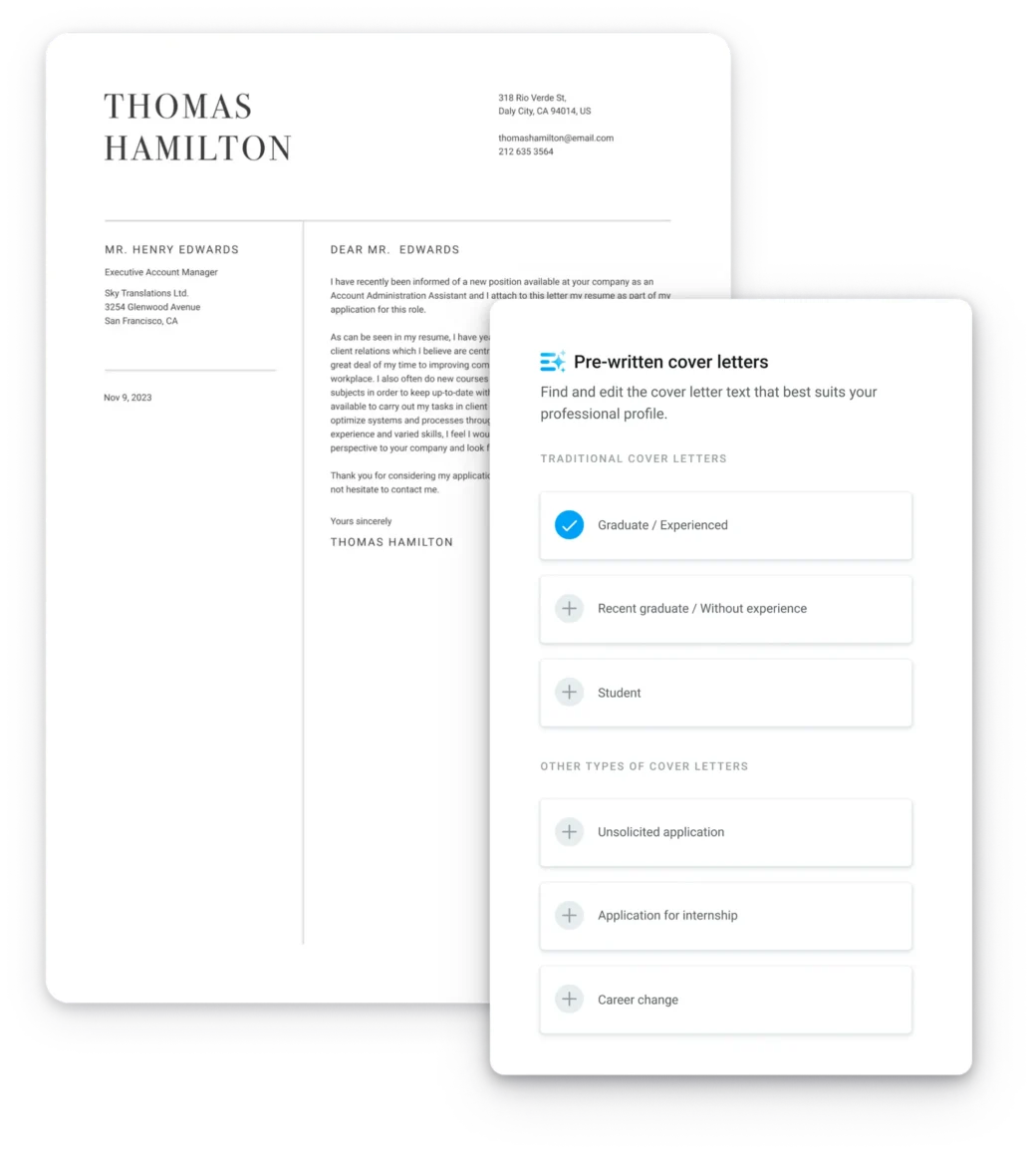
Motivation Letter Sample
Motivation letters are used for many reasons, so they can vary significantly. You can change the example in this section to fit your needs.
The motivation letter example below is about an entry-level job for Raul. He hasn’t held a paying job before, but he highlights experiences that might not be on his resume.
123 Address Street
Anywhere, USA 33333
September 10, 2022
ABC Company
456 Workplace Lane
Dear Mr. Smith:
As a first-generation university student, I am looking for a position that will enable me to pay my tuition while making allowances for my class schedule. When I saw your job listing for a weekend Customer Service Representative on the campus information board, I felt that we would be a perfect fit for each other’s needs.
While my on-the-job experience is limited, I have a great deal of experience in dealing with customers. Throughout my teenage years, I have helped out in the family business, a small convenience and souvenir store at the heart of a tourist district.
My duties there were often public-facing, arranging items for sale and assisting customers in finding what they needed. I always did my best to help customers leave with smiles on their faces, even going above and beyond what might be expected. This resulted in many 5-star reviews for the business on Tripadvisor and Google.
Thank you for your consideration. I’d be happy to speak with you in person or via phone to discuss the position and my qualifications further.
With gratitude:
Raul Ascencio
The following motivation letter example concerns an academic program. Sue is a high school senior seeking a summer internship after graduation. Her letter is imbued with a passion for the field as well as its relationship to her career goals.
March 1, 2023
Cindy Diver
Caribbean Coral Restoration Project
789 Coastal Road
Nassau, Bahamas
Dear Dr. Diver,
For as long as I can remember, I’ve wanted to do something to help reverse the damage humans have caused to our planet. For that reason, I was thrilled to receive an invitation to apply to the Caribbean Coral Restoration Project summer program.
Though I come from a landlocked state, I received my open water scuba certification from SDI last August. Training took place in a flooded quarry in Pembroke, Kentucky. I look forward to taking my first “real” oceanic open water dive in the warm waters near your research station.
During my high school education, I have pursued as many ecological opportunities as possible. I participated in the 4-H Club’s Wildlife Judging Team for four years, twice winning regional competitions. I also keep an action camera as a constant companion, participating in citizen science projects such as iNaturalist and Cornell University’s annual bird count.
I have been accepted into State University’s biology program, beginning next fall. After obtaining a bachelor’s degree in biology, I plan to pursue my master’s in marine biology. I hope to start that part of my journey with real field experience under my belt. Please feel free to contact me if you require any further information. My application and resume are enclosed.
Key Takeaways
With the correct format and style, you can create a motivation letter that can win over any recruiter. To do so remember the key points that were addressed in this guide.
- Motivation letters can effectively be used in place of cover letters when you have little experience or are applying to a university, internship, or volunteer program.
- Use professional business letter formats.
- Address your motivations and qualifications clearly in the body of your letter.
- Express your personality, passions, and motivations.
Ensuring your letter is written in this style will boost your chances whether you’re an entry-level employee or an experienced worker.
Discover the additional features of our online editor
- Editor available in 13 languages
- Create s everal resumes and cover letters
- Secure permanent storage
- Usable on a variety of devices
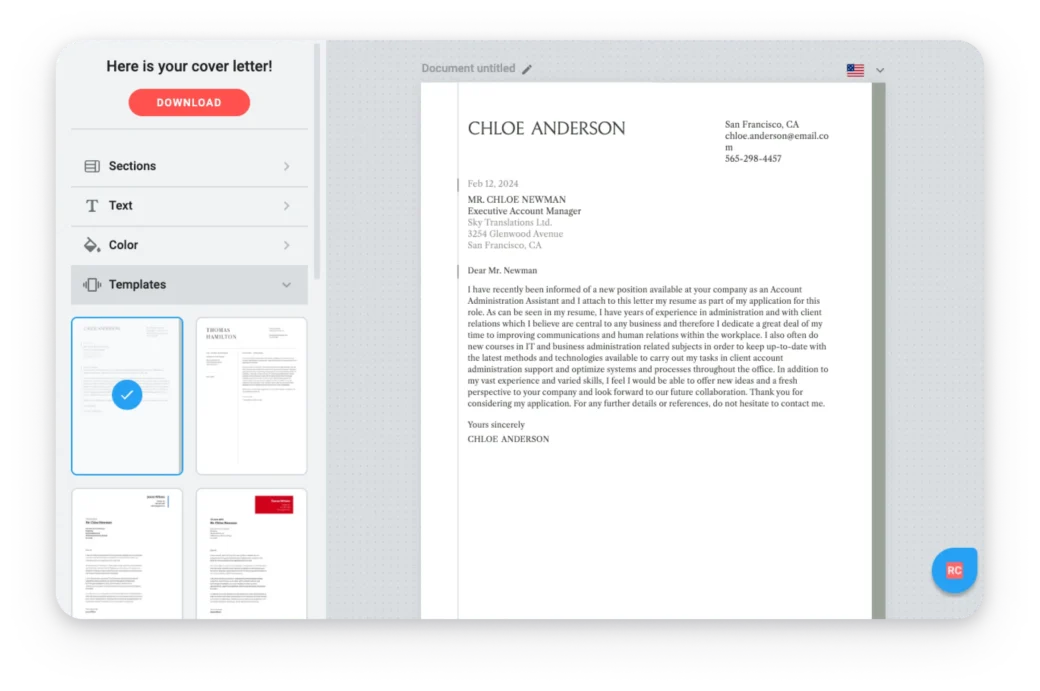
Related Posts

Trouble getting your Cover Letter started?
Beat the blank page with expert help.
Explore Jobs
- Jobs Near Me
- Remote Jobs
- Full Time Jobs
- Part Time Jobs
- Entry Level Jobs
- Work From Home Jobs
Find Specific Jobs
- $15 Per Hour Jobs
- $20 Per Hour Jobs
- Hiring Immediately Jobs
- High School Jobs
- H1b Visa Jobs
Explore Careers
- Business And Financial
- Architecture And Engineering
- Computer And Mathematical
Explore Professions
- What They Do
- Certifications
- Demographics
Best Companies
- Health Care
- Fortune 500
Explore Companies
- CEO And Executies
- Resume Builder
- Career Advice
- Explore Majors
- Questions And Answers
- Interview Questions
How To Write A Motivation Letter (With Examples)
- What Is A Mentor
- Mentor Traits
- Talent Management
- Performance Improvement Plan
- Performance Review Phrases
- Four Functions Of Management
- Difference Between Goals And Objectives
- How To Give Employees Feedback
- What Is An Operational Environment
- Key Success Factors
- How To Not Get Fired
- How To Be More Confident At Work
- One-On-One Meeting
- Performance Management
- Professional Development
- The Peter Principle
- Positive Feedback
- Low Hanging Fruit
- Upskill Your Employees
- Motivation Letter
Find a Job You Really Want In
Motivation letters are a type of cover letter that you write to accompany an application to a master’s program or a volunteering opportunity. Your motivation letter explains your interest in the opportunity, as well as adding additional information that didn’t fit in your application. Essentially, motivation letters are cover letters for unpaid positions .
A good motivation letter can have a big impact on your chances of acceptance. If you’re looking into applying for a scholastic program or volunteering program, or you want to improve a motivation letter you already have, then keep reading. This article will cover how to write the best motivation letter you can.
Key Takeaways:
A motivation letter is often included with an application to a graduate program or a volunteering position.
It’s a one page letter that outlines your skills and why you’re interested in the opportunity so think of it as a cover letter for unpaid positions.
A motivation letter is going to the program’s first glimpse of you as an individual, so be sure to make a positive impression.
A motivation letter is structured a lot like a essay and has an intro, a body that provides examples of your qualifications, and a conclusion that recaps what you said.

What is a motivation letter?
How to write a motivation letter, what to include in a motivation letter, motivation letter examples, tips for writing a motivation letter, motivation letter faq.
- Sign Up For More Advice and Jobs
Motivation letters serve as a chance for you to explain your professional, personal, or educational reasons for applying to programs. It gets submitted alongside other parts of your application, like a questionnaire, recommendations, and resume , but it lets you add some personality to your application .
Most often, you’ll submit a motivation letter when you apply for graduate programs, master’s degrees, or other non-professional programs. You will almost never be asked to write a motivation letter when you’re applying for a paid job.
Sometimes motivation letters are also called motivational letters or statements of purpose, so follow this guide for those letters as well.
When writing a motivation letter, you should consider what your motivation for applying is, create an outline, then proofread the letter when you’re done. Motivation letters aren’t very long, so any mistakes would really stand out to the reader – and you want to avoid making a bad impression.
Consider your motivation. The first thing you need to do before putting any words down is think about your motivation for applying. The letter is supposed to explain why you want to join the program and why you’d excel at it. You want to show why you’d be successful and a credit to the program.
Create an outline. Outlines are a way to order your thoughts. Motivation letters are typically written in essay style, so you can decide what parts you’ll cover in what paragraph. Your motivation should be multifaceted, and you want to convey that in your motivation letter.
Add a heading. Most motivation letters will be submitted online nowadays, so the heading isn’t always required. However, traditionally motivation letters had the date, your contact information, the name of the program, and their contact information on them.
Write an intro. The intro should summarize what you’re going to say in the body of the letter – just like with an essay. If you’re struggling writing your intro, skip it for now and come back after you’ve written the rest of the letter. That should make it easier to summarize what’s in the letter.
Delve into the body paragraphs. This is where you cover the reason you’re applying and why you’d be an asset to the program. Like with an essay, this should be two to three paragraphs, depending on length.
Don’t be afraid to go over the length limit the first time – you can always cut back later. Most motivation letters are going to contain short anecdotes to help explain why being a part of the program is important to you.
Conclude the letter. This should summarize your motivation and why you’d do well in the program. Make sure to thank the reader for their time as well as invite them to contact you with any questions.
Proofread. It’s extremely important to go over your letter again to check for errors or inconsistencies. If possible, have someone else read the letter for you as well – they’ll likely catch errors that you won’t. it’s important to have a well-written letter free of errors, so make sure to be serious about your proofreading.
If you can, it’s best to wait a short while before rereading your letter. It makes it easier to spot errors or awkward phrasing. And you should reread it more than once, because sometimes corrections can lead to other errors.
As with most business writing, there’s an expected format to follow when writing a motivation letter. You want to make sure to include all the necessary elements, such as a heading, intro, body paragraph, and conclusion. You also want to be sure to use the right format for your motivation letter.
Standard format. Be sure to use standard formatting (unless the instructions say otherwise), such as 1-inch margins, a space between paragraphs, and no indentations. Being able to follow standards, or directions, will be a point in your favor.
Heading. Depending on the specifications or guidelines you’re given, you might want to include a professional heading with your name, address, and phone number. This makes it easier for the organization to reach out to you.
Intro paragraph. Here’s where you can introduce yourself and talk about what interests you in the program. You can give a bit of background and explain why you’re applying to this program specifically.
Body section. In the middle two or three paragraphs, you can go in-depth about your experience and why you’re a good fit for the program . It’s a good idea to pick a few related skills or experiences to highlight in each paragraph.
Conclusion paragraph. In the last paragraph, you need to quickly summarize what makes you stand out and why you are passionate about the program. This can be a short paragraph with just a few sentences, just make sure to reiterate your argument and really sell yourself.
Sign off. This is a letter, after all, so make sure you include a closing. Pick something professional like “sincerely” or “best regards” to maintain an appropriate tone.
Example #1:
Dear Mr. Doe, My name is Jane Smith and I am currently pursuing a Bachelor’s Degree in Political Science at State University. I would like to formally apply for ABC Organization’s Summer at the Senate program for the 2022 year. I would love the opportunity to study with ABC Organization because I have admired your work, particularly in engaging minority communities to vote. As a political science student and potential future legislator, I care deeply about ensuring Americans can enact their right to vote. I would love to learn from ABC Organization through your hands-on and immersive summer program. I believe that I can be an asset to your ABC Organization because I am currently the head of my university’s debate team, I am passionate about voter rights, and I have a demonstrated history of political volunteer work. I am prepared to bring my skills to your program, as well as absorb everything I can learn during my summer in Washington D.C. Thank you for considering my candidacy and I hope to get the opportunity to work with ABC Organization this coming summer. Please feel free to contact me with any questions. I look forward to hearing from you. Sincerely, Jane Smith
Example #2:
Dear Dieter Cross, My name is Lloyd Bannings and I’m an undergraduate student at Virginia Commonwealth University, majoring in psychology. I’m writing to apply to your online master’s of science in family therapy program. My plan is become a family therapist , so I want to learn all I can about therapy and counseling techniques. I feel that your program would set up me up to be a well-rounded and effective therapist who can help others through difficult transitions in their life. I’ve been motivated to be a therapist ever since my parents divorced when I was young. While it was still difficult, being able to talk to a therapist made a huge difference in my life at the time, and I want to be able to do that for others. Northwestern is a well-known and respected name, and I know that your program is built on evidence-based practices. Being able to attend online will also make it easier to continue pursuing my education while being able to get started on my career. I believe that my drive to towards helping others through therapy and my studiousness will make me a natural fit for the program. I have been a diligent student at VCU and will be finishing my degree at the end of the semester, with an expected graduation date of June 2024. Thank for the time you’ve taken to consider my application and I hope to hear from you in the near future. If you have any questions or need any additional information from me, please contact me at [email protected]. Kind regards, Lloyd Bannings
When it comes to motivation letters, they all look different. That doesn’t mean that there aren’t a few tips you can follow to stand out. Here are a few ways you can improve your motivation letter:
Use the program requirements. Often programs will list certain requirements for admittance, so take a look and find the top few requirements that you meet. If the program has a specific mission or values, highlight how that fits in with your goals and own values. Show that you’re a good fit both in terms of requirements and outlook.
Don’t use jargon. You should make your letter approachable and readable, no matter who you think might be reading it.
Convince them you want to be there. Motivation letters are a great opportunity for you to talk about why you want to be at that program in particular. Highlight specific aspects of that program that make you want to attend, or tell them why this program will help you meet a career or life goal .
Look ahead. Getting into a program can be difficult, but you need to think about what you’ll do after finishing the program. It’s a good idea to talk about what you’ll do with your degree or certificate after you finish the experience so they know you’re thinking ahead.
Let your personality shine. Use this opportunity to show off your personality and express your fit for the program. Don’t just focus on your hard skills or experience, but talk about your soft skills and personality too.
Look for guidelines. Usually, organizations set specific guidelines for letters, like what font or page count they want. Make sure you look for these specifications and adhere to them as closely as you can.
Put your strengths first. It might be tempting to write an underdog story, but you shouldn’t sell yourself short. List your accomplishments and talk about your strengths instead of talking about challenges and shortcomings.
Make it personal. If you know who is on the application committee, you can address the letter to someone specific. Try to find a name and use a personal salutation.
Keep it concise. Motivation letters tend to be about a page long (but it can depend on different organizations’ guidelines). You want to make sure you keep everything concise and get right to the point.
Use a professional tone. At the end of the day, motivation letters are like cover letters and you should write them in a similar way. Use a professional tone and keep the letter more formal than casual so you can show your readers that you take this seriously.
Be original. Try to include experiences or skills that set you apart from other candidates . List your leadership skills, relevant studies, or any experience that ties you to the purpose of the program.
Get feedback. As with any formal writing, it’s always a good idea to have a friend look over your letter before you hit send. Have them look at the content as well as the grammar so you make sure you’re putting your best foot forward.
How long should a motivation letter be?
A motivation letter should be between 500 and 700 words, or about one page long. You should check the length requirement of where you are sending it to help determine the exact length of your letter.
What is the difference between a motivation letter and a cover letter?
A cover letter will have specific examples of your skills and experience for a job while a motivation letter will focus more on your personality and motivations for applying. Both letters will look very similar and have the same structure. The content will be different depending on the kind of letter that you are going to submit.
What is a mistake to avoid when writing a motivation letter?
A common mistake in a motivation letter would be forgetting to include the reason for choosing the program or university. It’s important to provide your reasonings as to why you want to apply and be a part of the program. You should also avoid addressing the wrong person and not explaining why you are a good fit for the program.
International Hellenic University – What Is a Motivation Letter?
EDUNation – How to Write a Good Motivation Letter
How useful was this post?
Click on a star to rate it!
Average rating / 5. Vote count:
No votes so far! Be the first to rate this post.

Amanda is a writer with experience in various industries, including travel, real estate, and career advice. After taking on internships and entry-level jobs, she is familiar with the job search process and landing that crucial first job. Included in her experience is work at an employer/intern matching startup where she marketed an intern database to employers and supported college interns looking for work experience.
Recent Job Searches
- Registered Nurse Jobs Resume Location
- Truck Driver Jobs Resume Location
- Call Center Representative Jobs Resume Location
- Customer Service Representative Jobs Resume
- Delivery Driver Jobs Resume Location
- Warehouse Worker Jobs Resume Location
- Account Executive Jobs Resume Location
- Sales Associate Jobs Resume Location
- Licensed Practical Nurse Jobs Resume Location
- Company Driver Jobs Resume
Related posts

What Is Online Networking? (And How To Do It)

10 Ways To Break Out Of Your Comfort Zone

How To Build Rapport With Anyone At Work (With Examples)

How To Give Positive Feedback At Work (With Examples)
- Career Advice >
- Get Promoted >
Build my resume
- Build a better resume in minutes
- Resume examples
- 2,000+ examples that work in 2024
- Resume templates
- 184 free templates for all levels
- Cover letters
- Cover letter generator
- It's like magic, we promise
- Cover letter examples
- Free downloads in Word & Docs
Ultimate Guide to Crafting a Winning Motivation Letter in 2024
The Fundamentals of Motivation Letters
- Mastering the Structure and Content
- Enhancing Your Motivation Letter
Review and Refine Your Motivation Letter
Motivation letter faqs.
Scholarships, degrees, volunteer roles, internships, and jobs share a key requirement: motivation.
No matter if you’re applying for a research position or hoping to score a scholarship, the person you’re writing to wants to know that you’re motivated, and beyond that, what motivates you. That’s why writing a motivation letter is very different from writing a cover letter —it’s not just about your qualifications but more about what makes you tick, your story, and what brought you to where you are now.
Writing a motivation letter that captures the reader from the get-go might seem tricky, but don’t worry—that’s what we’re here for. Check out our comprehensive guide for all the motivation letter tips, examples, and templates you could wish for.

Motivation letters, also known as—surprise—letters of motivation, are often a requirement for various academic programs, scholarships, volunteering, and more.
But what are they really , and how are they any different from, say, a letter of interest or even a cover letter? Buckle up because that’s what we’ll be discusssing below.
Introduction to motivation letters
A motivation letter is essentially a single-page introduction that you send, often alongside other required documents, to institutions, companies, or individuals that might be interested in them. You’ll mostly see these in academic contexts, be it scholarships or college applications.
Motivation letters are mostly used for:
- College admissions
- Scholarship applications
- Study abroad programs
- Research positions and fellowships
- Internships
- Volunteering
- Specialized workshops and conferences
- Rarely, job applications
More often than not, a motivation letter will be required if you’re applying for any of the above. Even if it’s not, writing one and discussing your background, what’s important to you about that particular program, and a little bit of personal motivations can be the thing that sets you apart from other candidates.
A motivation letter is different from a letter of interest , letter of introduction , letter of intent, or a cover letter, although you will sometimes see these terms used interchangeably. The goal is to discuss why you’re motivated to apply and how the opportunity fits into your long-term goals and plans.
Think of it as a sort of hype letter from you to the position you’re applying for. Sure, you might be sending several of these just in case you don’t get into your first choice, but the recipient doesn’t need to know that.
To them, it should sound like this is your dream field of study, your number one college, or a life-changing internship opportunity. And more importantly, it should explain just why you’re the best pick for the opening.
Knowing when to write a motivation letter
Seeing as people use the term “motivation letter” pretty loosely, you may find them used in the context of getting a job—especially in Europe. However, the most common use cases revolve around academic opportunities.
Below, we’ll explore three of the most popular scenarios and give you handy templates to use when crafting your own.
Applying for a college program
Most universities require a motivation letter as part of the application process. When writing one, your goal should be to go over your academic goals, but also your hobbies and interests .
Colleges are after well-rounded students who have something to bring to the table, so if you can express why this program and this school are both important to you, you’ll have one foot in the door!
Here’s a template you can use to get started on your own motivation letter:
University Motivation Letter
Jessica Alvarez 123 Pretend Ave. Stanford, CA 94305 [email protected] (650) 555-0123
April 18, 2024
Ms. Evelyn Harper Director of Admissions Office of Undergraduate Admission Stanford University 123 Pretend Ave. Stanford, CA 94305
Dear Ms. Harper,
I am writing to express my sincere interest in the master’s in environmental science at Stanford University. I’m a recent graduate, having completed the program at the University of Colorado Boulder. My dream has always been to pursue an environmental science degree at Stanford, and I hope to contribute my drive and passion for environmental issues in the upcoming class of 2025.
Growing up, I became acutely aware of the disastrous impact of climate change on our planet. From glaciers to global temperatures, the whole world is affected by the mistakes that we now have to work hard to fix. My goal has always been to address climate change through innovative research and sustainable practices. I hope to one day put my knowledge and skills to use by becoming a leader in environmental policy reform.
I know that the Environmental Science program at Stanford is one of the best in the country, but the prestige is not what drove me to apply. I feel that your course is comprehensive and aligns with my dream of making a significant impact on global sustainability efforts perfectly.
I have the utmost respect for Stanford University and I am confident that my knowledge of environmental science will be an asset to every project I participate in as well as a life-changing experience for me.
Thank you for considering my application. I am looking forward to the opportunity to discuss this with you in further detail at your convenience.
Sincerely, Jessica Alvarez
Applying for a scholarship
If you’re applying for a scholarship, a motivation letter is your golden opportunity—quite literally—to wow the recipient and explain to them why you are the most worthwhile candidate.
Scholarships are often few and far apart, and almost always, there’ll be more applicants than there are spots. This is why your letter needs to outline not just straight-up academic excellence, but also your future goals and what drives you to seek a scholarship. It’s okay (or even recommended) to be candid, but keep it professional.
Here’s a template to inspire you before you write your own letter of motivation:
Scholarship Motivation Letter
Jordan Padalecki 123 Pretend Ave. Atlanta, GA 30301 [email protected] (404) 555-6168
January 19, 2025
Mr. Thomas Griffin Scholarship Committee Coca-Cola Scholars Foundation 123 Pretend Ave. Atlanta, GA 30301
Dear Mr. Griffin,
My name is Jordan Padalecki and I have recently obtained my bachelor’s degree in computational media from the Georgia Institute of Technology. With great enthusiasm mixed with a dash of hope, I am writing to you to apply for the Coca-Cola Scholars Program. My dream has always been to utilize technology and media to develop educational programs that enhance learning experiences for underserved communities, and I hope that with your help, I will achieve my goals.
Throughout my education, I always strived to maintain good grades. I was an active student, with participation in coding hackathons and my role as a volunteer tutor for local community centers driving me always to learn more and do more. I’ve had my eyes on the prize from a young age, but now, I am faced with a problem that so many other students have to deal with—my situation doesn’t permit me to keep pursuing these goals and achieve my dream master’s degree in educational technology at the University of California.
Due to my family’s limited financial resources and the high costs associated with advanced education, securing funding through personal means is not feasible. This has driven me to apply for a scholarship, hoping to continue my education without the overwhelming burden of debt.
My family, as well as my past experiences, have instilled in me a profound sense of responsibility and drive for knowledge and success. I know that if I am given the chance, I will make the most out of every second at Berkeley and go on to create and implement innovative educational tools that can significantly improve learning outcomes in regions where access to technology is scarce.
I am eternally grateful for your time and your consideration. Please feel free to reach out with any questions, and I hope that we can discuss my application soon.
Sincerely, Jordan Padalecki
Applying for an internship
When applying for an internship, aside from deciding on a fantastic resume template , you should consider sending a motivation letter. In this iteration, the motivation letter is perhaps closest to a cover letter, but it’s not quite the same thing.
Focus this one on your enthusiasm for the field, your approach to learning, and how this internship can be transformative to your career—but don’t forget to throw in a few words on why you’re the best candidate for the role. (Hint: using a cover letter generator can be a good start to give you some ideas.)
Here’s an example template for this type of motivation letter:
Internship Motivation Letter
Daniel Romanescu 123 Pretend Ave. Redmond, WA 98052 [email protected] (425) 555-0147
June 13, 2024
Ms. Jamila Coughlan Internship Coordinator Microsoft Corporation 123 Pretend Ave. Redmond, WA 98052
Dear Ms. Coughlan,
I am reaching out to express my enthusiastic interest in the Software Engineering Internship at Microsoft. As a recent graduate in computer science from the University of Washington and a lifelong programming enthusiast, I am eager to apply the theoretical knowledge and skills I’ve acquired in a real-world setting. I believe that my proficiency in C# and Python, as well as my experience with cloud services, will allow me to make an impact during my time at Microsoft.
I started my education at the University of Washington with a clear goal: becoming a software engineer. Not only do I find programming fascinating, but I am also motivated by the potential to develop software solutions that can improve everyday life for millions of users. My coursework in advanced programming techniques and cloud computing has provided me with a solid foundation in critical software development skills and cloud integration, and I am keen to further develop these skills through hands-on experience.
During a prior internship at a local tech startup, I was able to lead a team project that developed a comment section under every news post, resulting in a 30% increase in user engagement in the application. I am confident that these experiences, alongside my proactive approach and strong work ethic, will allow me to make a meaningful contribution to the software development team at Microsoft.
I am excited about the opportunity to bring my talents and my drive to Microsoft Corporation as an intern and I couldn’t be more eager to learn from your industry-leading experts.
I look forward to discussing this opportunity during an interview. Thank you so much for your consideration.
Sincerely, Daniel Romanescu
Mastering the Structure and Content of Motivation Letters

You may have a bucketful of motivation and an eagerness to work hard and do your best, but the recipient of your letter of motivation won’t know that unless you make it clear from the get-go.
People often get hundreds of letters, meaning that some of them end up in the bin. To prevent that from happening to yours, it’s important to structure it in a compelling way—which is what we’ll talk about below.
Structuring your motivation letter
Although any and all templates should be used as a starting point and not as a fill-in-the-blanks process, you should still stick to a traditional structure in a motivation letter. Surprise the reader with the content and hook them in with a strong intro, all the while making sure that your letter makes sense and flows well.
Right, but how do you structure all of that in a way that makes sense? Here’s our secret recipe for a winning letter of motivation.
Greeting and intro
To ensure that the recipient reads your letter, you need to chuck all generic greetings and intros out of the window. A personalized greeting is where it’s at, and if possible, try to address the recipient by name.
After the greeting, introduce yourself and state the purpose of your letter in the first sentence. Then, quickly dive into what sets you apart from others, be it your admirable drive or relevant skill set. This is just a single paragraph, but every sentence needs to be highly impactful.
Body of the letter
The next two to three paragraphs make up the body of your letter of motivation. This is where you can elaborate on the things you already briefly touched on in the intro.
In most letters, you’ll want to start by discussing your academic background and/or professional experience , and diving into what led you to where you are now. Mention any relevant coursework, group projects, extracurriculars, or volunteer work that aligns well with the opportunity.
In the second paragraph, switch gears to talking about your motivations and aspirations . This is especially important in letters tailored for scholarships, or those applying for jobs at nonprofits or volunteer positions. If you have personal reasons that drove you to reach out to this particular company or institution, shout them from the rooftops right here.
Conclusion and signoff
In the final paragraph, thank the reader for their consideration. Then, throw in a so-called call to action, meaning a sentence that drives them to act; such as “I look forward to discussing this opportunity during an interview.”
Sign off with a simple, “Sincerely, [your name].”
Crafting a compelling narrative
Your job is to tell a story, and this story needs to hit a few beats. You need to drive the point home that you’re interested in this particular opportunity and nothing else.
Next, you need to show what got you to where you are now— why are you interested in this, and what are you hoping to achieve?
Lastly, treat your qualifications as a cherry on top that shows that you’ve put a lot of effort into your field of interest and that you can’t wait to keep doing the same with this new opportunity.
Creating your motivation letter with not just the structure, but also the narrative in mind, will make for a more engaging read, and that’s always a good thing.
Here are some useful tips for this part of the process:
- Look for connections. How do your background and education align with the opportunity you’re applying to? What about your motivations and goals? When writing your letter, look for opportunities to make these little connections. Instead of just saying: “I’m driven,” say: “I was particularly impressed with the success of your track team, and I believe that my drive to keep training and do even better would make me fit right in with the class of 2025.”
- Get a little personal. Chances are that the recipient of your letter is getting many more of them from other people, and if they can all essentially be summed up as “Hi, pick me, thank you,” not a single one will stand out. That’s why getting a little personal is recommended, but make sure to keep your tone professional. Discuss why you, as a person and not just as a student or as an employee, dream of landing this opportunity.
- Drive the point home. When you’re concluding your letter, it’s a good idea to include a sentence that summarizes the contents and compels the reader to get back to you. An example of that can be, “My background in computer science and my love for coding position me as a strong candidate for the software engineering internship program at [company]. I look forward to discussing this with you further in any manner that suits you.”
Enhancing Your Motivation Letter with Advanced Strategies

Getting to the point where you have a draft may take some time, but even if you’re feeling eager, don’t send your letter just yet. Hold your horses! It’s important to polish this letter to perfection.
Check out our tips on some more advanced strategies that will give your letter that little bit of extra charm.
Personalizing your letter
We’ll share a harsh truth with you: a letter of motivation that is not personalized is most likely going to end up in the trash with the rest of the application.
People in charge of admissions, scholarships, and recruiting all receive so much correspondence that even top-notch applicants get overlooked. This is why being generic is a killer, and personalizing your letter is the way to go.
What can you do to make sure your application practically screams, “I’ve done my homework” and gets picked out of a hundred other letters?
- Do lots of research. You can’t create an effective letter without knowing the place you’re applying to in and out. Before you even start writing, learn about the company or organization and take notes on some of the programs and recent achievements. Mention them in your letter if they’re relevant.
- Tap into mission and values. Start with the basics—what is the core mission of the organization, and what values does it uphold? Knowing this allows you to tailor your narrative in a way that echoes the principles they want to see. In your research, go beyond just a simple skim of the About Us page and see if the organization is involved in any charitable work or has made any mission statements.
- Talk about specific programs. Look for specific programs, initiatives, or projects that excite you and relate to your field of interest. Mentioning these not only shows that you’ve done your homework but also that you are genuinely enthusiastic about contributing to these areas.
- Show some personality. Some letters need to be super formal, but while we don’t advise being casual, it’s okay to let go of the reins a little in your motivation letter. Let your personality shine through the words on the page and show how important this is to you.
Avoiding common mistakes
Writing a motivation letter means striking a delicate balance between personal expression and professional appeal. That makes it equally tricky as writing a resume , but it’s made harder by the fact that you won’t have a handy resume checker to look through your work for you at the end of the process.
Some of the pitfalls we discuss below need to be avoided like the plague.
- Don’t be generic. We’ve talked about this, but it warrants repeating in its own little section. Being generic is a surefire way to be ignored. It can be tiring, but avoid using a one-size-fits-all approach and write a new motivation letter from scratch for each position that you truly care about.
- Avoid clichés. Motivation letters kind of lend themselves to clichés, but try to steer clear of them. Saying something like “This is my dream and I’m a hard worker” is both generic and irrelevant. Instead, get specific, delving deeper into what this opportunity means to you. For example: “Ever since my childhood dog developed kidney disease and I helped my parents look after him, I knew that I wanted to become a veterinarian and help other animals through their pain. I know that studying at [college] is not a walk in the park, but that is precisely why I chose it—I want to work hard and become the best vet I can be.”
- Know when to stop. Even if you have a lot to say, it’s important to be concise and to the point. Your letter should always fit a single page and should ideally have no more than four to five paragraphs.

We’re almost at the finish line. You have your letter, it’s looking fantastic, and you’re itching to send it off so that you can count the days until you get a response.
That’s all well and good, but before you hit that tantalizing “Send” button, make sure to apply these finishing touches for even better effect.
Proofreading and editing
Our number one tip? Proofread your letter and then (figuratively) sleep on it. ****Don’t send this very important letter as soon as you finish it after working on it until 5 in the morning. Instead, proofread it once, get some sleep, edit it again, and then send it off. You don’t want to appear unprofessional.
Your editing process should go beyond a quick check for typos. Start by checking your grammar and punctuation. A good tip to spot mistakes is to read your letter starting with the final paragraph—it’ll appear fresh in your mind and help your brain identify potential problem areas.
Next, check for coherence and flow. Ensure that the story you want to tell is easy to follow; adjust paragraph length; cut unnecessary words and sentences. Your letter needs to be concise and impactful.
Lastly, consider your tone. Motivation letters tend to have a more personal edge than, let’s say, a ChatGPT cover letter —but they’re still addressed to professionals, not friends. Make sure that you’re coming off as candid and respectful.
Seeking feedback
To help you further, here are some common mistakes to avoid in counter offer letters.
Let’s be real—writing a letter of motivation takes time. It’s probably taken you a few hours by this point, if not longer, and with breaks, the whole process can sometimes take days.
After that much time, your brain will become so used to every turn of phrase and every word in the letter that you’ll become far less likely to spot any mistakes.
This is why a fresh pair of eyes can help, but not just to proofread or fix the flow. Asking the right person to give you feedback on your letter is often a crucial part of writing it.
This is especially common in academic settings. When applying for colleges, you’ll ask your teachers for review, and then revise your letter based on their feedback. Similarly, applying for a master’s program or an internship gets a lot easier if you ask a professor or two to give you their opinion.
Turn to your friends, colleagues, mentors, or coaches and gather all feedback you can—it’s often tremendously helpful.

Leveraging Templates and Samples for Success

As you may have gathered, these letters are highly, highly, highly personalized, so you might think that using templates is completely out the window.
Not true—there are ways to streamline the process and make it a little bit easier on you, all the while still maintaining high quality in your writing. Here’s what you can do.
Utilizing resources
Templates are a good way to make the process less tedious. We’ve shared some handy options for you up above. However, you might now be wondering if these are even okay to use, given the personal nature of motivation letters.
Don’t worry—you’re in the clear. Go ahead and use a template. The catch? You should never use it word-for-word.
A motivation letter template or sample is a starting point. It’s meant to show you how to structure your letter and, roughly, what to talk about. Instead of copy-pasting a template and filling in the blanks, use it to plan out your own outline, with an intro, a couple of body paragraphs, and a strong closer.
The same thing applies to writing a resume. You can use resume examples or a resume builder to get the job done in two minutes, but that’s just the beginning. From there, you’ll add and edit everything to make sure it aligns with your background and expertise.
Samples can be useful if you’re short on ideas, too. They can give you some guidance on what to talk about. The rule of thumb here is the more specific, the better—instead of following the sample exactly, do some digging and identify interesting programs or projects to personalize your letter with.
When using examples from templates, make sure to adapt them to your context. For instance, if the template discusses being compassionate and wanting to care for others, this is lovely, but won’t apply to every job or college degree. Think of your own ideas, write them down, and then pick the ones that best apply.
Last but not least, use your own voice. It’s very easy to tell when something was written by someone else or by AI generators. If your personality shines through, your chances for success will be much greater.
Conclusion and encouragement
With the help of your own research and our comprehensive guide, you now know how to write the perfect letter of motivation.
You’re ready to start strong with a compelling intro, discuss your background, experience, and goals in the body paragraphs, and sign off with the perfect closer. You know that your letter needs to be full of your own unique voice and personalized to a fault.
If you’ve done everything you could and you’re still not sure, you might have one final obstacle to defeat: overthinking.
Have you ever heard of analysis paralysis? It’s basically what happens when you overthink something so much that you can’t act on it anymore.
This often affects people who are working on resumes, cover letters, or motivation letters, both due to the high stakes and due to the fact that they’ve been working on them for hours on end.
If this is you, and you’ve spent hours and hours writing the perfect letter, but you’re still not sure, we’re here to tell you to just go for it.
A well-written motivation letter may be all that it takes for you to stand out and secure your dream position, be it a master’s program at the college of your dreams or an internship with a company that you hope to work for in the future. There’s a lot to gain and nothing to lose.
After several rounds of editing and some feedback from others, once your letter is ready, send it in with confidence. You’ve done everything you can at this point, so don’t be afraid to go ahead and just do it!

Start with a personalized greeting, preferably addressing the recipient by name (this takes some research). Next, in the first paragraph, quickly introduce yourself, state the purpose of your letter, and express why you’re interested in this opportunity. Use a couple of paragraphs to discuss your goals, qualifications, and what led you to apply to this particular place. Lastly, sign off with a call to action that inspires the reader to get in touch, and make sure to thank them for their consideration.
A letter of motivation should take up a single page and a maximum of four to five paragraphs, although certain positions only require a short three-paragraph letter. It should be concise and impactful enough to maintain the reader’s interest throughout, but not short enough to fail to accurately describe why you’re an awesome pick for the opportunity.
Avoid being generic and overly fluffy—your letter needs to be to the point. Stay positive, respectful, and grateful, avoiding falling into demanding or too informal tones. Focus on your strengths and motivations, and even if you’re unhappy with something, such as your previous school or job, never mention it in this letter.
While a motivation letter should reflect your personality and enthusiasm, it’s crucial to maintain a professional tone. The level of formality can be adjusted slightly based on the culture of the organization or institution, but it should never be overly casual or stray into informality. The only exception is if the opportunity specifically demands it, but that’s very, very rare.
Yes and no. A motivation letter serves a similar purpose, in that it introduces you, your background, and your goals to an opportunity you’re interested in, be it volunteer work or a scholarship. However, a cover letter is succinct, job-oriented, and focused on your career achievements. Motivation letters dig deeper into who you are and why you’re interested in a particular position; besides, it’s more often used in academic contexts.
Related articles
- Letter of Interest Examples
- Letter of Introduction
- How to Accept a Job Offer
- Resignation Letter
- How to Write a Resume

How to write a Motivation Letter 2023 & Examples
How to write a Motivation Letter? Here is the answer to this question, in addition to identifying all its sections and methods of preparation. Other than having a stellar resume, a motivation…
Motivation Letter - How to write a Motivation Letter 2023 & Examples
- Motivation Letter
How to write a Motivation Letter? Here is the answer to this question, in addition to identifying all its sections and methods of preparation. Other than having a stellar resume, a motivation letter is a great way to convince a selection panel to pick your application for an opening. Unlike a cover letter that accompanies…

Sarah Reynolds
Content specialist.

How to write a Motivation Letter? Here is the answer to this question, in addition to identifying all its sections and methods of preparation.
Other than having a stellar resume , a motivation letter is a great way to convince a selection panel to pick your application for an opening.
Unlike a cover letter that accompanies your resume when you’re looking for a job, a motivation letter is used when you’re applying to a college or university, a non-profit organization, an internship, or a volunteer program.
A cover letter highlights how your qualifications match the job you’re applying for while a motivation letter explains your passions and reasons for wanting to join an organization.
In this article, you will learn about:
- What is a motivation letter.
- How to write a motivation letter.
- Important examples and tips.
How do you explain motivation in a job?
Writing a motivation letter can be quite simple to do if you follow some guidelines.
It just involves putting into words what drives you and why you should be considered for a position in the organization.
Use your letter to let the recipient know that you’re passionate about what you do, and that your skills will be a good addition to their organization.
Read more: Chronological Resume Writing Guide
Guide to writing your motivation letter
To get you started, create an outline for your letter that’ll guide you as you write.
In the outline, include the reasons you’re interested in the school or organization, your skills and how they’ll fit into the program, and the reason behind your application.
After you’ve done that, you can start writing your letter. If you get stuck, you can use your outline for pointers.
You can register on our site and get a lot of customizable templates to create a professional CV with ease.
How to structure your motivation letter
Your motivation letter should include:
- An introduction
- A body (between 3-7 paragraphs)
- A conclusion
How do you start a motivation letter?
Just like any other letter, your motivation letter should include a section where you introduce yourself to the organization.
Tell the recipient of the letter who you are, what you do, and the position you’re applying for.
As this is the beginning of your letter, it is important to make it captivating and attention-grabbing.
If it’s bland you’ll lose the recipient’s interest.
What do you say in a motivation letter?
Use the body of your letter to appeal to the recipient as much as you can.
Mention your skills, your experiences, and your passions. Use descriptive words to sell yourself but don’t lie.
A genuine, well-written letter speaks volumes compared to one riddled with lies and extravagant claims.
Your letter should include:
- The reason for your application. Why do you want to join the school or organization?
- Your top skills and qualities that will be beneficial to the organization.
Read more: 50+ Resume Objective Examples: Career Objectives for All Jobs
How do you end a motivation letter?
Wrap up your motivation letter with a few lines that summarize your goals and leave a lasting impression on the recipient.
Your conclusion should be about 2-3 lines long and should include an appreciation to the reader for considering your application for the position.
You can also ask them to contact you in the event they need additional information or clarification.
When you’re done writing, proofread your letter.
You can use a grammar editor to weed out spelling errors and other grammatical issues in your motivation letter.
The aim is to make your letter interesting, professional and error-free.
Tips for writing your motivation letter
To make your letter even more compelling and convincing to the admissions panel, we’ve compiled some tips for you that you can use when writing.
- Adhere to guidelines Most applications come with strict guidelines about the length and content they want to be reflected in your motivation letter. The instructions may also include formatting details like font style and size, the common ones being Times New Roman or Arial in size 12.
- Align your letter to the program’s requirements Aside from the guidelines, you should also write your letter per the requirements of the program. The skills you talk about should be close to those that the recruiters are looking for. Show the recipients that your values are in line with those of the organization and the type of candidates they’re looking for.
- Address the recipient directly A motivation letter is a good way to let your personality shine through. Share your experiences with details that show your feelings and unique perspectives to the reader. Even though you’ll write in a formal language, keep your letter light and conversational. It also works to your advantage if you know the exact recipient of your motivation letter so you can address them by name and official title, as this will add a personal touch to your letter.
- Use simple language Using technical terms or a lot of jargon in your letter may alienate the reader. Although you want to showcase your knowledge, a motivation letter is meant to be simple to read and understand. Your qualifications will speak for you in your resume. Write your letter in short, unambiguous, and easy-to-read sentences that can be understood universally.
- Be truthful You may be tempted to write things that are untrue to make your letter more alluring. But seasoned interviewers can easily detect made-up stories and you’ll be tossed out without a second thought. Instead, focus on your letter on your strengths and achievements.
Read more: Writing a Resume without Work Experience
Examples of motivation letters
If you’re still unsure of how to write your letter, we’ve included two examples below to show you how you can get it done.
College application motivation letter example
Dear Ms. McCloud,
My name is Mallory Cooper, a student at Andes High School in Boston, with an interest in acting and on-stage performance. I am writing to apply for the BFA in Dramatic Arts in The School of Drama at The New School in New York City.
I hope to become an actress in the future, and I believe studying under your instruction will set me on that path. It has been a dream of mine since childhood to become an actress on Broadway.
My love for acting is a deep one, as I have been doing it for a long time. I was first cast in a play when I was 5 years old, in our school’s production of The Cautionary Tale of Humpty Dumpty. From then on, I have been an active member of drama clubs from elementary school through high school, and I hope to spend the rest of my life bringing joy to people through my performances.
The New School is renowned for its excellence in Performance Art training. It has also birthed many actresses and actors, most of whom are my personal icons. Under the tutelage of your qualified teaching staff, I am confident that I will become one of the best actresses of my generation.
I am a hardworking person, who is open to experiences that aim to challenge me as well as help me grow in my craft. Not only do I have a background in stage acting, but I also have a bit of experience as an assistant director in my community theater. I’m sure I will thrive in your drama program.
Thank you for interest in my application and for considering me for the position.
Contact me on my email [email protected] for further information.
Mallory Cooper
Volunteer Motivation Letter Example
Dear Dr. Cullman,
I am writing to express my interest in the volunteer program at Children of Hope Orphanage in L.A, that was posted on your website in late August. I am a recent graduate from Zoe University with a degree in Psychology.
I am interested in taking up the position as a counselor in your institution because I have a passion for helping children and it is also my area of study. Having grown up in an orphanage myself, I know that my experiences as well as my education, can be put to good use in your organization.
While in college, I volunteered in other children’s homes like Opal Home for Destitute Children and Faith House. In both institutions, I worked under licensed psychologists to help counsel the children in safe, loving environments and also learn how to connect with them.
I am very interested in working with you and your team because your organization is larger and offers more support to children. Your commitment to advocating for children’s rights in various capacities is also a force behind my interest in joining your team. Your core values align with my own beliefs that all children should have access to a nurturing atmosphere despite their circumstances.
In conclusion, I feel that I would be a valuable addition to your organization as we work towards protecting children and safeguarding their future.
Please contact me at [email protected] for inquiries into my application.
Yours sincerely,
Paul Stein.
Read more: How To Write a Resume
FAQ about ” How to write a Motivation Letter”
1-what do you write in a motivational letter.
- Discover more.
- Your motivation letter must be unique to you.
- Adopt a straightforward, succinct tone.
- Concentrate on your strong suits.
- Keep your resume in mind.
- Obtain the ideal equilibrium.
- Explicitly state why you are doing it.
- Talk about your goals for your career.
2-How do you start a motivational letter?
In the opening, state your purpose and introduce yourself. In the body, highlight your experiences. In the end, thank the reader for their time. Always be truthful, do your research, and demonstrate real interest.
3-How long should my motivation letter be?
A motivational letter should be between 500 and 700 words long (or whatever length is recommended by your dream institution). But worry about this after you’ve finished writing the draft, and only consider it when you’re editing your draft to make it more manageable.
4-How do you end a motivational letter?
Be sure to express gratitude for their time and consideration at the conclusion of your motivational letter. Use a formal ending salutation, such as “Sincerely,” “Best regards,” or “Thank you for your consideration.” Stay away from overused words and phrases like “Yours,” “Cheers,” and “Take care.”
5-What is difference between cover letter and motivation?
In contrast to a cover letter , which is used to apply for jobs, a motivation letter is typically written to request admission to a university, acceptance into a program, or approval to volunteer at a nonprofit.
6-How do I write a motivation letter with no experience?
Write down what distinguishes you and what skills you have, such as:
the ability to work well with others through teamwork. demonstrates your capacity to learn on the job. your accomplishments and contributions that distinguish you as a standout candidate. Work that you’ve done while in school or as a volunteer that highlights your abilities and contributions
In Conclusion
Your motivation letter can make or break your application.
Therefore, you should take enough time to write it so that you can convince the recipients of your suitability for the position.
It should be honest, personal, and well-written, allowing the readers to see your personality and the motivation behind your application.
You’ll have exclusive access to the appropriate format, structure, and language that only the top experts in the field utilize on their resumes thanks to our team at StylingCV.
Related articles

40 Resume Summary Examples (How-to Guide)
![101 Essential Skills to Put on a Resume [For Any Job] 101 Essential Skills to Put on a Resume [For Any Job]](https://stylingcv.com/wp-content/uploads/2020/11/skills-to-put-on-resume.jpg)
101 Essential Skills to Put on a Resume [For Any Job]
Build your resume in 10 minutes.
Use professional field-tested resume templates that follow the exact ‘resume rules’ employers look for. Create My Resume
Hundreds of Resume Templates
Choose from hundreds of professionally designed and ATS-friendly resume templates Build Your Resume Fast and Easy.

Want Free Resume Templates?
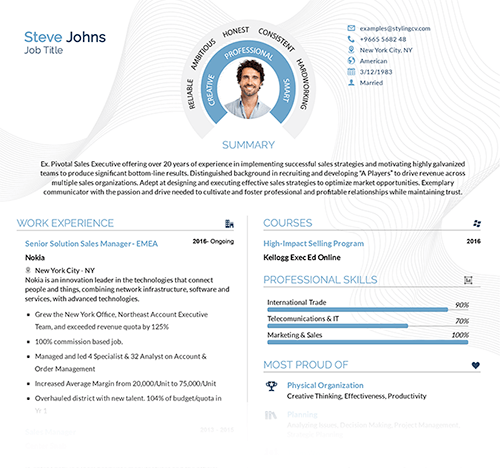

5 Inspiring Examples: Writing a Motivation Letter (Key Elements)
By Status.net Editorial Team on January 12, 2024 — 10 minutes to read
Crafting a compelling motivation letter can be the deciding factor in whether you land your dream job, secure a place at a prestigious university, or win a competitive scholarship. A motivation letter goes beyond a simple cover letter or personal statement; it’s an opportunity to convey your unique story, professional aspirations, and the driving forces behind your career or academic pursuits.
In this article, we will explore the key elements that make a motivation letter stand out from the crowd. We’ll provide practical tips on how to articulate your goals, showcase your achievements, and demonstrate your passion in a way that resonates with decision-makers. We will share examples to guide and inspire you as you write a motivation letter that leaves a lasting impression.
Structuring Your Motivation Letter
Opening: crafting a compelling introduction.
Start your motivation letter with a catchy opening line. Connecting to the reader on a personal level is key to grabbing their attention. For example, you could mention a shared experience, or your journey towards deciding to apply for the position or course you’re interested in.
In the first paragraph, make sure to briefly introduce yourself and explain your reason for applying. It’s important to also mention how you heard about the opportunity. Keep it concise and focus on setting the tone for the rest of the letter.
Body: Highlighting Your Qualifications
After introducing yourself, it’s time to provide the reader with a clear view of your qualifications and achievements. Use bullet points to organize your information in an easy-to-digest format. Focus on:
- Relevant education or training
- Skills and experiences that match the requirements
- Accomplishments that demonstrate your abilities
For each point, provide a brief example to illustrate how you meet the criteria. Remember to keep it focused on the opportunity you’re applying for, and avoid including unrelated qualifications.
- Bachelor’s degree in Marketing from (…) University
- Two years of experience in content creation and social media management
- Increased engagement rates by 15% during my tenure at (…) Company
Closing: Ending with a Strong Conclusion
In the final section of your motivation letter, sum up why you think you’re the right candidate for the opportunity. Emphasize your enthusiasm and drive to succeed in the position or program.
Finally, express your gratitude for being considered and provide contact information where you can be reached. Remember to stay confident but polite, and remind the reader that you’re looking forward to discussing your qualifications further with them.
An example of a closing could look like:
Thank you for considering my application. I believe that my skills and experiences make me an excellent fit for this opportunity, and I am eager to contribute to your team’s success. I look forward to the possibility of discussing my qualifications further. Please feel free to reach me at (your email) or (your phone number).
Personalizing Your Letter
Reflecting your personality.
When writing your motivation letter, it’s essential to show who you are, rather than just tell . Start by thinking about your strengths, skills, and personal traits that make you unique. Consider what aspects of your personality fit well with the institution or company’s values. For example, if the company values teamwork and you have a history of working well in team settings, you should emphasize this in your letter.
To help with personalization:
- List down three key traits that represent you.
- For each trait, write down a specific example of how you have demonstrated this quality.
- Connect the examples to the position or opportunity you are applying for.
Connecting with the Institution or Company
To create a personal connection, research the institution or company thoroughly. Familiarize yourself with their mission, values, and projects or programs. When writing your motivation letter, be sure to weave in details that show you have taken the time to truly understand the institution’s or company’s goals.
- If you’re applying for an internship at a sustainability-focused company, you can mention how your passion for the environment aligns with the company’s mission.
- If you’re applying for a university program, you can include your genuine interest in the program’s unique offerings, such as their lab facilities or specific courses.
To connect with the institution or company:
- Research their mission, values, and notable projects or programs.
- Identify aspects that align with your skills, interests, or values.
- Incorporate these connections into your motivation letter, explaining why they resonate with you.
Key Elements to Include
Relevance to the position or course.
In your motivation letter, always highlight how your background, skills, and experiences are relevant to the position or course you’re applying for. For example, if you’re applying for a management position, you can emphasize your previous leadership roles and your ability to lead teams to success.
- Use bullet points to list your relevant skills and experiences
- Mention any specific courses or certifications you have that relate to the position
Specific Achievements and Experiences
Showcase your specific achievements and experiences that make you stand out from other candidates. Use concrete examples to demonstrate your abilities, such as:
- Successfully completed a project on time and within budget, leading a team of five members
- Increased sales by 15% over a six-month period, as a sales representative at (…) Company
(Don’t forget to include any awards or recognition you’ve received: they reinforce your credibility and capabilities.)
Future Goals and Aspirations
Lastly, discuss your future goals and aspirations as they relate to the position or course you’re applying for. This shows that you have a clear vision of where you want to be, and how this opportunity aligns with your long-term plans. For example, you could say something like:
- “I hope to contribute to the company’s success by implementing new strategies and ideas, eventually progressing into a senior leadership role.”
Revising and Refining
Proofreading for errors.
In this stage of developing your motivation letter, you need to focus on the accuracy and clarity of your language. Mistakes in grammar, punctuation, and spelling can leave a negative impression on the reader. Take your time to read through your letter multiple times, checking for any errors and correcting them. Consider using the following strategies:
- Read Out Loud : Reading your letter out loud will help you catch awkward phrasings, repetitions, or sentence structures that may not be apparent when reading silently. It might also make it easier to spot grammatical errors.
- Use Spell Check : Take advantage of your word processor’s spell check feature to catch common spelling mistakes. Be cautious, though, as it might not catch context-specific errors or homophones (e.g., there/their/they’re).
- Check Punctuation : Accurate punctuation contributes to the clarity and professionalism of your letter. Make sure you’ve used commas, colons, and semicolons correctly, as well as proper capitalization.
Asking for Feedback
Another important aspect of revising your motivation letter is seeking feedback from others. A fresh pair of eyes can help you identify areas that need improvement, point out errors you may have missed, and provide helpful suggestions for strengthening your content. Consider the following steps when asking for feedback:
- Choose the Right Person : Seek input from someone who knows about the opportunity you’re applying for, or who has good writing and editing skills. This could include a mentor, teacher, friend, or family member.
- Provide Context : Briefly explain the purpose of the motivation letter, your goals, and any specific instructions or requirements you need to adhere to as you are writing.
- Request Specific Feedback : Ask your reviewer to focus on content, clarity, and tone, as well as grammar and punctuation. Encourage them to point out any confusing sections or suggestions for improvement.
- Revise Based on Feedback : After receiving feedback, carefully review the suggestions and revise your motivation letter accordingly. Remember, you don’t have to implement every suggestion, but consider each one as it applies to your specific situation.
Sample Motivation Letters
Academic applications.
When applying for academic programs, it’s essential to highlight your passion for the subject, your academic achievements, and your dedication to pursuing further studies.
Dear Admissions Committee,
I am excited to apply for the Master’s program in Environmental Science at [University Name]. As a highly motivated individual, I have always been passionate about environmental preservation and sustainable practices. During my Bachelor’s degree in Environmental Studies at [College Name], I maintained a 3.8 GPA and actively participated in multiple eco-friendly activities and volunteering projects.
I am confident that my background and enthusiasm make me a great fit for this Master’s program. Thank you for considering my application.
Sincerely, [Name]
Example of a motivational statement for educational purposes
Subject: Motivation Letter for the Master’s Program in Environmental Sciences
Dear [Admissions Committee],
I am writing to express my strong interest in the Environmental Sciences Master’s program at [University Name]. My passion for environmental conservation, along with my undergraduate studies in biology, has driven me to pursue a path that combines academic research and practical application in the field.
During my time at [Previous College], I completed an honors thesis on the impact of climate change on marine ecosystems. This experience fueled my desire to delve further into this field and contribute to finding sustainable solutions. By joining the Master’s program at [University Name], I hope to gain advanced knowledge in environmental science and learn from renowned experts in the field.
I am confident that the Master’s program in Environmental Sciences at [University Name] will provide me with the necessary skills and resources to make a meaningful impact in the field. I look forward to joining your esteemed community of scholars.
[Your Name]
Job applications
For job applications, focus on your skills, qualifications, and motivation for joining the specific company.
Dear Hiring Manager,
I am writing to express my interest in the Marketing Manager position at [Company Name]. With over five years of experience in the marketing field and a proven track record of success, I believe I can contribute significantly to your team and help achieve the company’s goals.
I recently completed a marketing certification in digital marketing, which has equipped me with the knowledge to create effective online campaigns. I believe that combining my practical experience and newly acquired skills will allow me to bring fresh, innovative ideas to your marketing team.
Thank you for considering my application. I am excited about the prospect of joining [Company Name] and eagerly anticipate the opportunity to discuss further.
Sincerely, [Name]
Example of a compelling motivation letter for a job
Subject: Motivation Letter for the Marketing Coordinator Position
Dear [Hiring Manager’s Name],
I am excited to apply for the Marketing Coordinator role at [Company Name]. As a passionate marketing professional with 3 years of experience in the field, I believe my skills and experience would make a valuable addition to your team.
Throughout my career, I have demonstrated the ability to develop and execute successful marketing campaigns. In my previous role at [Previous Company Name], I increased social media engagement by 50% and assisted in coordinating successful events, bringing in over 200 attendees.
I am particularly drawn to [Company Name] because of its innovative approach to marketing and commitment to continuous improvement. I look forward to contributing my ideas and enthusiasm to help your team achieve even greater success.
Thank you for considering my application. I would be thrilled for the opportunity to discuss my qualifications further and am available for an interview at your earliest convenience.
Sincerely, [Your Name]
Brief yet effective motivation letter for a job
Subject: Application for the Sales Manager Position
Dear [Hiring Manager],
I am eager to apply for the Sales Manager role at [Company Name], where I believe my proven track record in leading sales teams will make me a valuable asset.
In my previous role as a Sales Team Lead, I was able to achieve and surpass quarterly sales targets by an average of 20%. My ability to motivate my team and implement effective sales strategies would translate well into the Sales Manager position at [Company Name].
I am excited about the opportunity to bring my skills and experience to [Company Name] and look forward to discussing my qualifications further.
Best regards,
Frequently Asked Questions
What are the essential components to include in a motivation letter.
In a motivation letter, it’s important to include the following components:
- A concise introduction with a clear purpose statement
- An explanation of your interest in the role or program
- Your relevant qualifications, skills, and experiences
- Examples of how you can contribute or make an impact
- A polite closing with a call to action or thank-you statement
How should a motivation letter be structured for maximum impact?
For a well-structured motivation letter, follow these guidelines:
- Start with a specific and concise statement of your purpose
- Use short paragraphs to maintain readability
- Organize your content logically, covering interest, qualifications, examples, and conclusion
- Use topic sentences to guide the reader and transition smoothly between paragraphs
- End with a polite closing and clear call to action.
- 5 Key Parts of an Effective Cover Letter (with Examples)
- 7 Parts of a Business Letter (Components with Examples)
- Summary of Qualifications: 50 Powerful Action Verbs & 2 Examples
- A Perfect Letter of Introduction [Examples]
- 3 Examples: How to Write an Effective Application Letter
- Resume vs. Cover Letter (Thoughtful Tips)
How to Write a Motivational Letter [Examples and Tips]
![motivation letter best examples How to Write a Motivational Letter [Examples and Tips]](https://jofibostorage.blob.core.windows.net/blog/Motivational-letter-small.jpg)
Writing a motivational letter can be a tough nut to crack. How do you make sure you don’t appear as a Generic Jane or Joe?
With a well written motivational letter you’ll vastly improve your chances of getting invited to an interview or being accepted into your dream college. Read on to learn how to write your own motivation letter.
In this article we will go through the following:
What is a motivation letter?
How to write a motivation letter, motivation letter samples, tips for writing your motivation letter.
A motivation letter - also called a motivational letter or a letter of motivation - is a letter of introduction used for applications. It is usually accompanied by a resume or a CV .
However, you should not confuse it with a traditional cover letter , which is only used for regular job applications to paid jobs. With a cover letter the goal is to highlight your achievements and skills in order to be considered for a paid position.
When to use a motivation letter
When should you use a motivation letter then? A motivation letter is used in these five situations:
- When applying to a university or college (undergraduate, graduate, or postgraduate)
- When applying for a student programme
- When applying for a non-profit organization
- When applying for volunteer work
- When applying for an internship
A motivation letter is not usually used when applying to paid positions. That’s where you would use your cover letter.
Now that you know a little more about what a motivational letter is, and when to use it, it’s time to get your hands a little more dirty. It’s time to write a motivational letter.
Like your cover letter you should divide your motivation letter into three parts. The first part consists of salutation and introduction. Next part is your story and motivation - this is the body of your motivation letter. Lastly is the third part, your call to action, where you wrap things up.
We’ve split up the steps to write a motivation letter in to five steps below here.
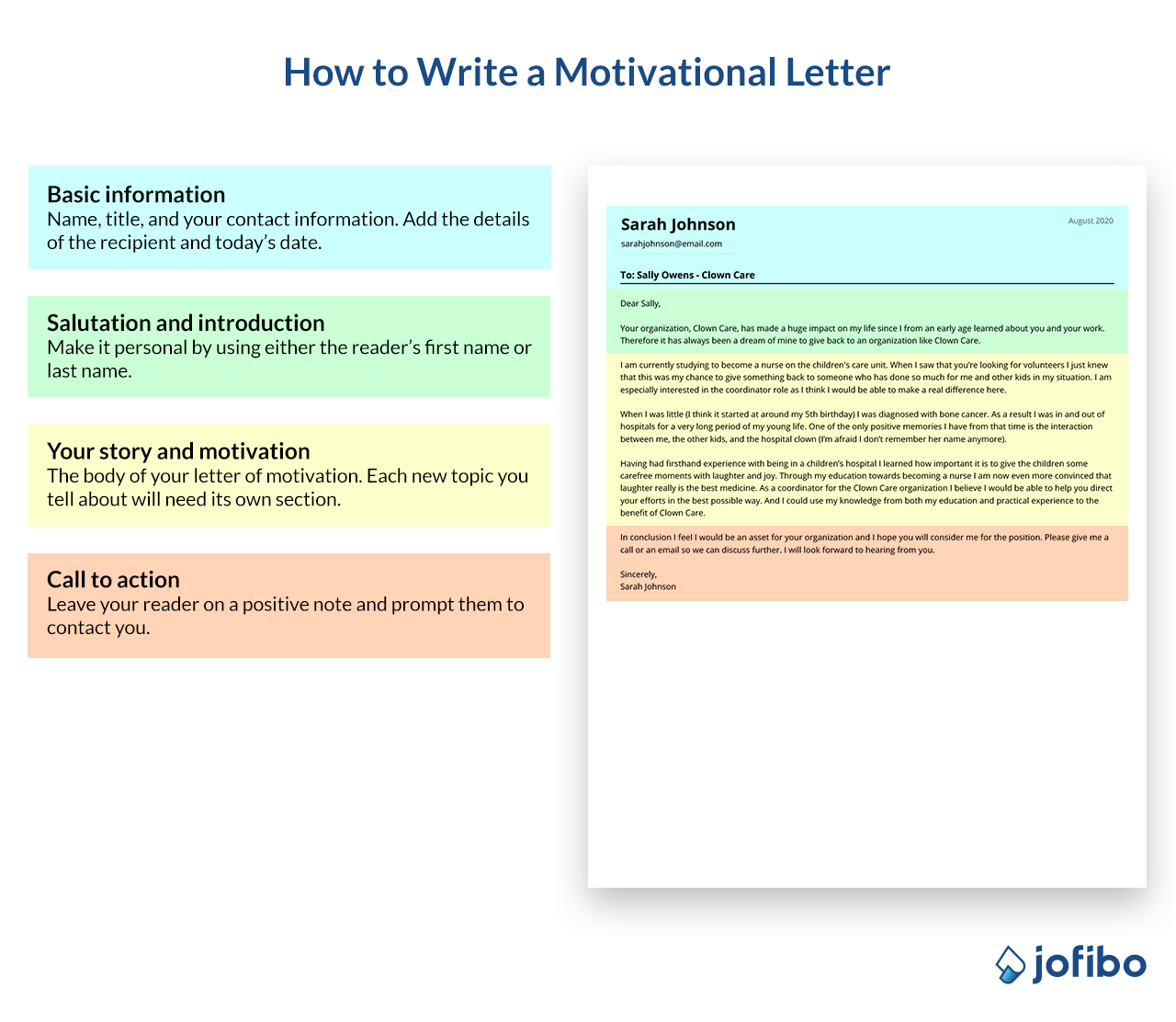
Step 1: Basic information
Let’s start with the easiest part - your basic information. This consists of your details such as name, title (if applicable), and contact information. Now add the details of the recipient (the person you’re addressing the letter to) and today’s date.
Step 2: Salutation and introduction
The salutation is, although small, an important part of your motivation letter. It’s important to make it personal so ideally you should use either the reader’s first name or last name.
You’ll also need to write an introduction that captures your reader’s attention to prompt them to read on. One way of doing so is by including a personal detail that intrigues the reader. You can also add an impressive achievement that is relevant.
Dear Sally,
Your organization, Clown Care, has made a huge impact on my life since I from an early age learned about you and your work. Therefore it has always been a dream of mine to give back to an organization like Clown Care.
You will want to hook the reader and make them interested in what you have to offer.
Step 3: Your story and motivation
The next step contains the body of your letter of motivation. This is where you need to sell yourself. You’ll want to expand it from your introduction to keep a natural flow.
Divide your content into smaller sections. Each new topic you tell about will need its own section. This ensures that there is plenty of white space in your motivation letter so you don’t overwhelm your reader with one large blob of text.
Example
I am currently studying to become a nurse on the children's care unit. When I saw that you’re looking for volunteers I just knew that this was my chance to give something back to someone who has done so much for me and other kids in my situation. I am especially interested in the coordinator role as I think I would be able to make a real difference here.
When I was little (I think it started at around my 5th birthday) I was diagnosed with bone cancer. As a result I was in and out of hospitals for a very long period of my young life. One of the only positive memories I have from that time is the interaction between me, the other kids, and the hospital clown (I’m afraid I don’t remember her name anymore).
Having had firsthand experience with being in a children’s hospital I learned how important it is to give the children some carefree moments with laughter and joy. Through my education towards becoming a nurse I am now even more convinced that laughter really is the best medicine. As a coordinator for the Clown Care organization I believe I would be able to help you direct your efforts in the best possible way. And I could use my knowledge from both my education and practical experience to the benefit of Clown Care.
Our applicant uses several compelling facts to make her point and to convince the reader why she would be a perfect match for the volunteer position.
Step 4: Call to action
The last part of your motivation letter is what marketers name the “call to action”. It means you leave your reader on a positive note and that your prompt them to contact you.
In conclusion I feel I would be an asset for your organization and I hope you will consider me for the position. Please give me a call or an email so we can discuss further. I will look forward to hearing from you.
Sarah Johnson
Step 5: Proofread your letter
The fifth and final step of your motivation letter is to proofread it. Making sure that your letter is flawless ensures that you appear professional and competent.
- Correct spelling and grammar mistakes
- Weed out any awkward sentences
- Edit information that is repeated from your resume so your motivation letter only includes unique and new information
It may be necessary to go through your letter more than once in order to make sure you’ve caught all small errors and typos. If time permits it, it’s a good idea to return to your motivation letter two days after completion as this will allow you to view it more objectively. If you feel insecure about your own skills as a proofreader (and it can be difficult to review your own work, trust me) you can ask a trusted friend or family member to go through your motivation letter for you.
Below are some motivational letter samples for different situations. You can use these as a guide and inspiration for your own motivation letters.
Volunteer work application

Text for motivation letter you can copy
Having had firsthand experience with being in a children’s hospital I learned how important it is to give the children some carefree moments with laughter and joy. Through my education towards becoming a nurse I am now even more convinced that laughter really is the best medicine. As a coordinator for the Clown Care organization I believe I would be able to help you direct your efforts in the best possible way. And I could use my knowledge from both my education and practical experience to the benefit of Clown Care.
College application
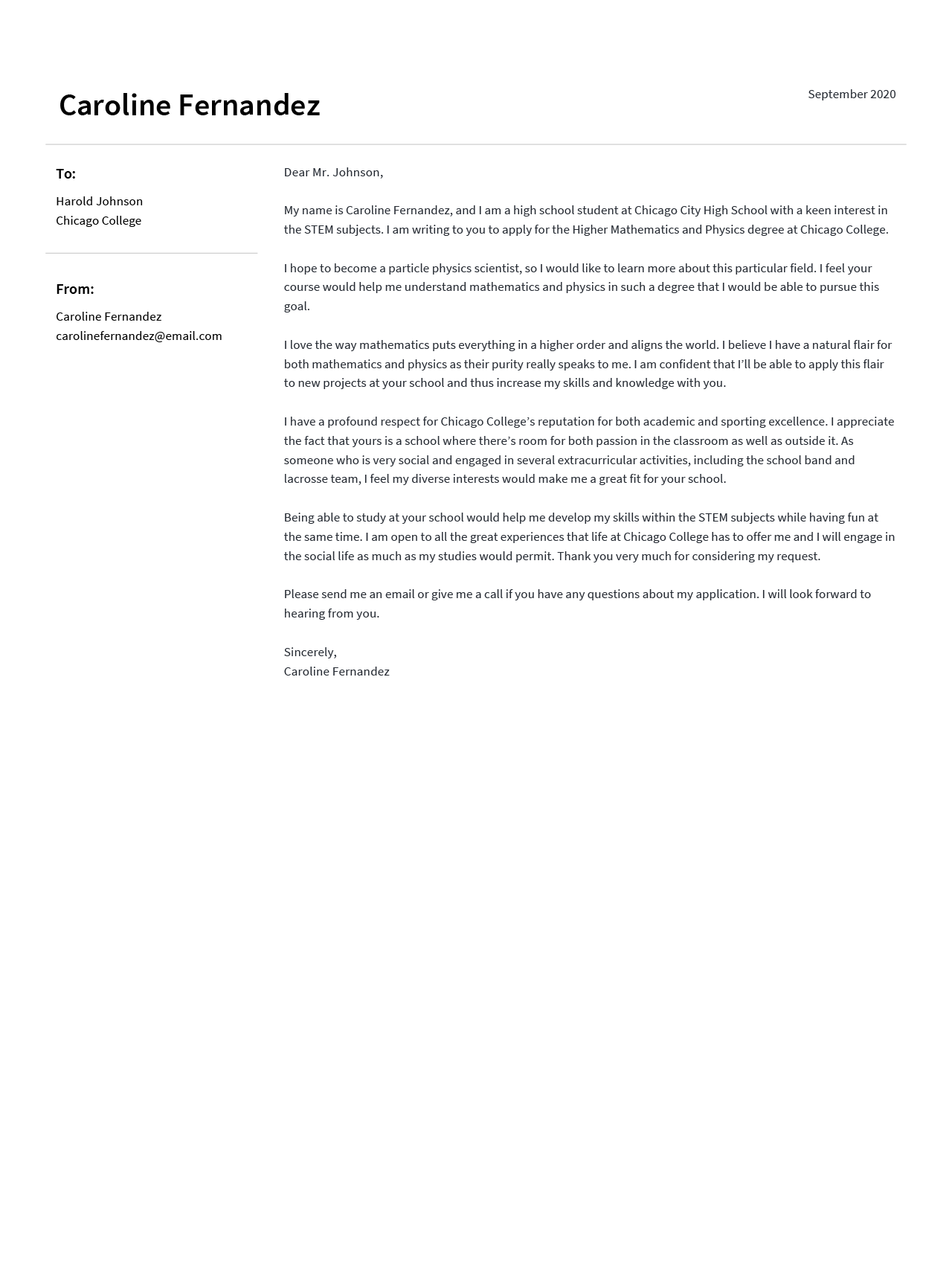
Dear Mr. Johnson,
My name is Caroline Fernandez, and I am a high school student at Chicago City High School with a keen interest in the STEM subjects. I am writing to you to apply for the Higher Mathematics and Physics degree at Chicago College.
I hope to become a particle physics scientist, so I would like to learn more about this particular field. I feel your course would help me understand mathematics and physics in such a degree that I would be able to pursue this goal.
I love the way mathematics puts everything in a higher order and aligns the world. I believe I have a natural flair for both mathematics and physics as their purity really speaks to me. I am confident that I’ll be able to apply this flair to new projects at your school and thus increase my skills and knowledge with you.
I have a profound respect for Chicago College’s reputation for both academic and sporting excellence. I appreciate the fact that yours is a school where there’s room for both passion in the classroom as well as outside it. As someone who is very social and engaged in several extracurricular activities, including the school band and lacrosse team, I feel my diverse interests would make me a great fit for your school.
Being able to study at your school would help me develop my skills within the STEM subjects while having fun at the same time. I am open to all the great experiences that life at Chicago College has to offer me and I will engage in the social life as much as my studies would permit. Thank you very much for considering my request.
Please send me an email or give me a call if you have any questions about my application. I will look forward to hearing from you.
Caroline Fernandez
Internship application
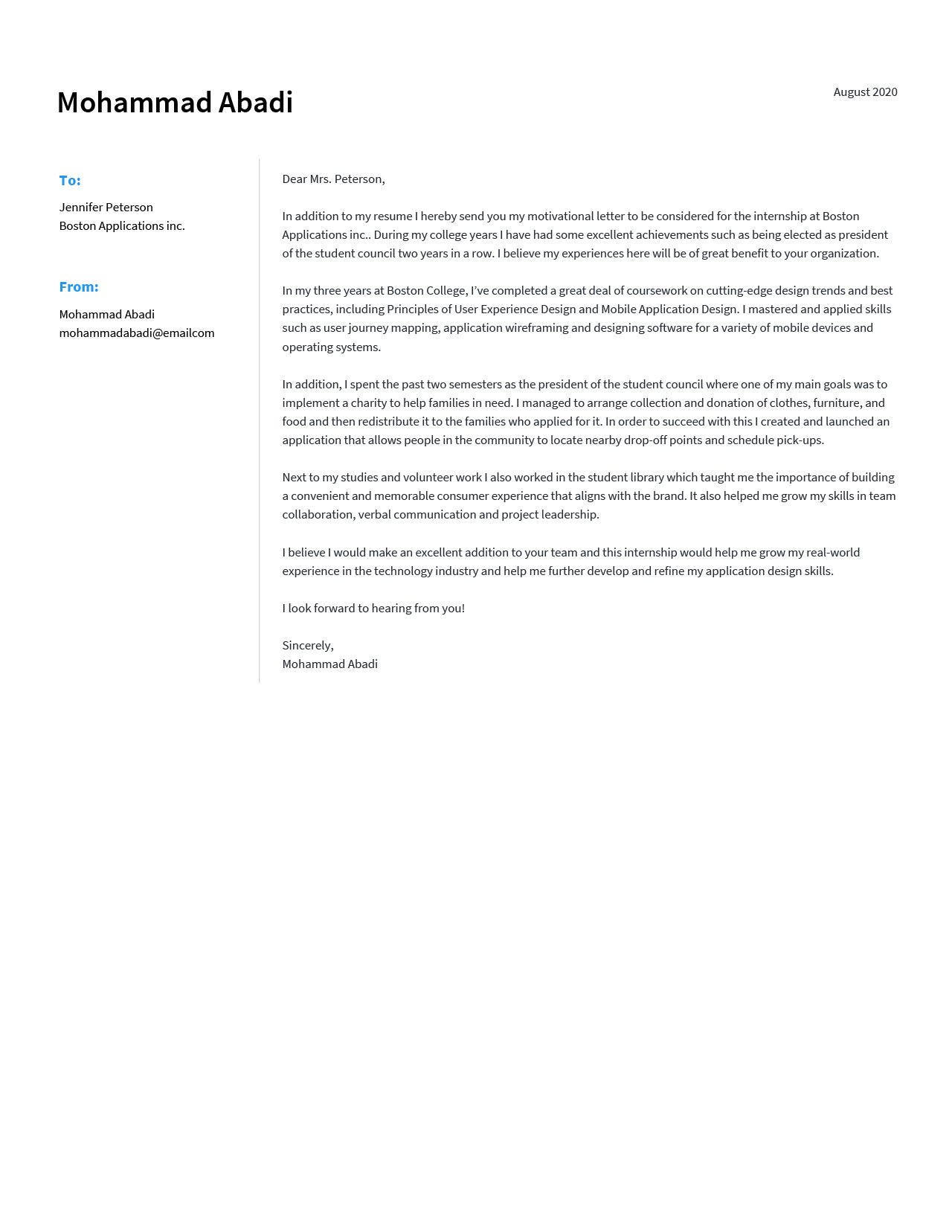
Dear Mrs. Peterson,
In addition to my resume I hereby send you my motivational letter to be considered for the internship at Boston Applications inc.. During my college years I have had some excellent achievements such as being elected as president of the student council two years in a row. I believe my experiences here will be of great benefit to your organization.
In my three years at Boston College, I’ve completed a great deal of coursework on cutting-edge design trends and best practices, including Principles of User Experience Design and Mobile Application Design. I mastered and applied skills such as user journey mapping, application wireframing and designing software for a variety of mobile devices and operating systems.
In addition, I spent the past two semesters as the president of the student council where one of my main goals was to implement a charity to help families in need. I managed to arrange collection and donation of clothes, furniture, and food and then redistribute it to the families who applied for it. In order to succeed with this I created and launched an application that allows people in the community to locate nearby drop-off points and schedule pick-ups.
Next to my studies and volunteer work I also worked in the student library which taught me the importance of building a convenient and memorable consumer experience that aligns with the brand. It also helped me grow my skills in team collaboration, verbal communication and project leadership.
I believe I would make an excellent addition to your team and this internship would help me grow my real-world experience in the technology industry and help me further develop and refine my application design skills.
I look forward to hearing from you!
Mohammad Abadi
Now that you’ve read about motivational letters and seen some different takes on them, it’s time for you to give it a go. Before you start though, here are our best tips for writing a motivation letter.
1. Keep it simple
Some organizations will provide you with guidelines (see tip #3) and others won’t. If you don’t have any specific guidelines make sure you keep your motivation letter simple. Keep it to ½ to one page with a basic 11-12 point font like Arial or Calibri.
Use everyday language that readers can easily understand and avoid slang or complex jargon. Writing short, active sentences is your best bet.
2. Let your personality shine through
There is only one of you, so make sure that your unique personality shines through in your text. Write about your interests, feelings, and perspectives. This is an effective way of separating your letter from others. Use a natural voice just like you would if you were in the room talking to your reader. However, avoid using too much humor as this is easily misinterpreted.
3. Follow guidelines provided by the organization
If the organization that you’re sending a motivational letter to has provided you with any guidelines make sure you follow them. This could involve formatting, length, and content guidelines.
4. Focus on your strengths
Write about how you can add value to the organization you’re applying for by focusing on your personal strengths. Writing about your strengths instead of your challenges and limitations will show you as a strong candidate.
Alright, let’s sum up what we’ve covered in this article:
- Writing a motivational letter can be difficult, but if you follow our guide you get a head start
- A motivation letter is not the same as a cover letter - you only use it in certain situations and not for paid positions
- A motivation letter should include the same basic elements as a formal business letter
- Divide your motivation letter into different sections - avoid writing one big blob of text. Remember the white space
- Tell your story and motivation for seeking the position. Keep it simple yet personal
Although a motivation letter is not identical to a cover letter they both follow the same standards regarding layout and formatting. Want to create your own motivation letter?
Create my motivation letter
Other popular resources
![motivation letter best examples The Best CV Format For Freshers [examples]](https://jofibostorage.blob.core.windows.net/blog/the-best-cv-format-for-freshers-header.png)
The Best CV Format For Freshers [examples]
How do you decide on a CV format for freshers? Discover which CV formats are best suited for freshers.
![motivation letter best examples Front End Developer Resume [Guide & Examples]](https://jofibostorage.blob.core.windows.net/blog/front-end-developer-resume-example-and-guide-header.png)
Front End Developer Resume [Guide & Examples]
Looking for help or inspiration? Learn how to create a great Front End Developer resume with our guide and examples.

6 Ways To Stay Motivated During Your Job Hunt
Personal motivation is key to maintaining most aspects of life. Setting personal and professional goals and staying determined will yield fruitful results.
Need a Professional CV or Resume?
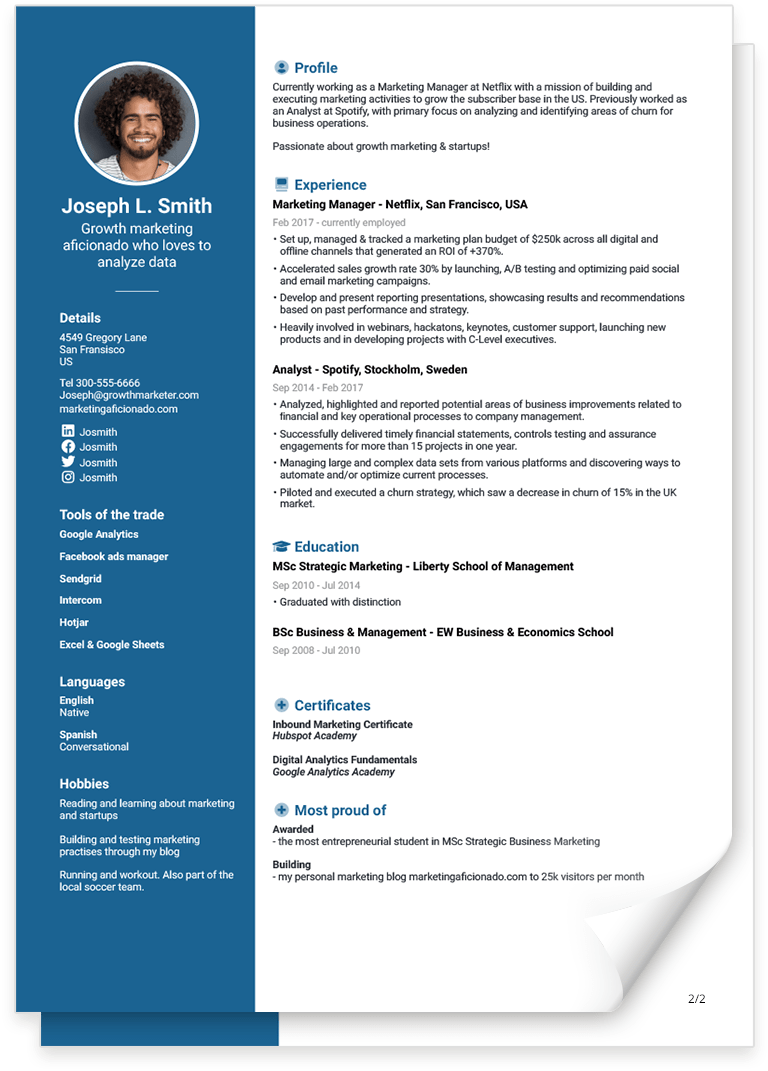
This feature is not available yet,
Download Your Eye-Catching Resume Now!
To download your resume simply upgrade to Premium Membership. You’ll gain instant full access to all our features.
- Unlimited PDF Downloads
- Unlimited Resumes
- Unlimited Cover Letters
- Access to all templates
- Cancel any time

- All Articles
- Before You Start
- How To Get In
- Being a Student
- Good To Know
How to write a successful motivational letter - Easy to use guide with free templates

Most university courses, from undergraduate degrees onwards, expect a fair bit from applicants. Not only does each course have set academic requirements and forms to fill out; most applicants will also be asked to provide examples of their work, a CV, and even undertake special course-specific preparatory exams. Many masters courses – especially some very competitive ones, like the top MBA s – encourage applicants to obtain letters of recommendation from senior colleagues or academic supervisors. Atop this sheaf of papers sits the most intimidating prospect of all: the motivational letter.
Free Motivation letter templates for your first job application
Free Motivation letter templates for an internship application
A motivational letter, also known as a personal statement or a cover letter, is a short piece of writing all about you; your past, your ambitions, your personality, and your interests. While completing CVs and forms can be a little dry and boring, motivational letters can be hard to write . The combination of needing to produce such an intimate piece of writing, worded in such a way that it comes across as both authentic and professional, and then using it to sell yourself to a university, creates the perfect recipe for social awkwardness and writer’s block.
Despite the difficulty of writing a decent motivational letter, it’s a fundamental skill in today’s jobs market – once you leave full-time education, you’ll need to write motivational letters to potential employers . With this in mind, writing a motivational letter for a masters degree is excellent practice. Below, we’ve prepared a couple of fail-safe techniques you can apply to writing a motivational letter so that it won’t either sound sterile or arrogant, and will help you stand out from the crowd.

Cover the basics: The central function of a motivational letter is to convince the admissions team at the university of your choice to offer you a place, or invite you to interview. Make sure that the letter is structured in such a way that it serves this purpose – it is usual to conclude a motivational letter by asking directly that you be admitted or invited for interview, depending upon what the next step of the admissions process is. Equally important is the calibre of your written language; if your motivational letter is riddled with grammatical errors or spelling mistakes, or doesn’t make sense, the university will almost certainly refuse to admit you. A great starting point is to look at some templates for motivational letters in your chosen field, to see how they are structured, and what key points you need to cover.
Get personal: A standard for all cover letters – including those for job-seekers – is that you must address your letter to a specific person. For your masters course, it could be the Head of Department, or the academic staff member responsible for your masters study programme . If you will be working closely with an academic supervisor – as with most research degrees – your cover-letter should be addressed to the academic you’d prefer to supervise you. Use the university’s website to figure out who the right person is, and address the letter to them using their name and title.
Show, don’t tell: This is true of CVs, and is true of motivational letters too. “I am a good leader” sounds a lot weaker than “I led a group of my fellow students on a week long climbing expedition, where we successfully…”. Avoid any overly ambiguous statements, as these can diminish the confidence the admissions team may have in your motivations. Also, make sure not to show things twice – if you’ve discussed something extensively in your CV, don’t dwell on it in your motivational letter.
Do your research: Academic institutions often have a lot to say about their values, priorities and vision. What’s your target institution’s motto? Do they prioritise sports , arts , or something else? Do they have a statement of values? How do you reflect these things? The most important question to think about in relation to these things – why is it that you want to go here? Weaving your knowledge of these things into your letter is a great way to assure admissions tutors that your choice to study at their institution is an informed one.
Be specific: One of the biggest problems at application is that candidates don’t adequately explain why it is they want to study what they’ve applied for. Remember, you’ve got to explain your choice of subject, and your choice of institution. Not just “Why Biology ?” but “Why Biology at this university?” If you don’t yet have answers to this question, then it is well worth going through the University’s website again, to work out what inspired you to take the next step, and apply for your chosen course.
Write a story: People love stories. They like to be taken on a journey, and brought to a satisfying conclusion. A list of superlatives or accomplishments is nowhere near as compelling as an epic story that weaves all that you’ve done into a coherent account, that supports the choice you’ve made to apply. Like all stories, make sure your motivational letter has a clear beginning, a middle, and an end . These should all follow logically on from one another, so that the reader is left feeling convinced of the suitability of your chosen course and institution, to your skills, experience, and goals.
Be interesting: This is without doubt the most important feature of a motivational letter – you absolutely must capture the reader’s interest. If you come across as boring (or worse, bored) on paper, it’s much less likely that you’ll get a positive reply. But furthermore, the interest you express has got to be personal, and it must relate directly to your motives . It’s absolutely no use whatever to produce some bland, boring page or two about hard work and how interested you are in your subject. This is exactly what every other candidate will write, and for the most competitive courses, you will want to stand out. But the best way to do this is not to try to be someone else; be yourself. Mention the fact that you like juggling. Talk about how you felt when your father was laid off work. Begin from your earliest memory. So long as what you say relates to what makes you the person you are, and then why that person has chosen to apply for this course, it deserves to be there.
What underscores all these points is a simple, and very ancient, piece of advice; know thyself . Nobody expects you to have everything figured out when you apply for a masters, but they will at least expect you to have a firm grasp of what you want out of the degree you’ve chosen to apply for. It’s in nobody’s interests for students to undertake courses for which they are ill-prepared, or that they haven’t really thought through – all you need to do is show your chosen university that this doesn’t apply to you.
And let’s face it; a masters degree is a fantastic opportunity, that will allow you to gain an expert understanding of a field about which you are passionate, and will build a bridge to a career that excites you – what could be easier to write about than that? But if you prefer to get some guidance, have a look at our motivational letter templates below.
Example 1: Motivation Letter for a Masters of Science Degree (MSc)
Dear sir /Madam,
My name is [name] and most recently I have been working as a [job title] at [company name]. I hold a B.Sc degree in [subject] from [university name].
The undergraduate curriculum in [subject], [university name], introduced me to a wide variety of subjects in the field of [subject]. Various courses like [course 1], [course 2], [course 3] (name all relevant courses) provided me with a strong footing in [subject of the masters degree].
While offering both depth and breadth across this field, these courses put into perspective the importance and relevance of [subject] and the application of its fundamentals to the problems faced by the real world.
I am much eager to adopt and know new technologies. I am really enthusiastic to attend a Master of [subject] at [university name] in order to understand different [subject] concepts and its applications to more complex real life situations. The good reputation of high-quality education standards, an extremely distinguished faculty members, and research facilities are the factors which have motivated me to apply for my masters studies at [university name].
Moreover, I feel I am responsible for making a big move in this field and this scholarship will give me a big chance to be one day someone who is remembered for his innovations. I think it is our duty as people sharing life in this world to make our future better because the future is not only ours. The next generation should be proud of us one day when they look back and find how hard we worked to make the world a better place. I believe my qualification and your needs would be an excellent fit. I will be happy to provide any further information or documents if required. I look forward to your positive response. Thank you for your time and consideration.
Kind regards,

Example 2: Motivation Letter for a Masters of Art Degree (M.A.)
Dear Prof. [name],
I am writing to inform you of my interest in the Masters of Arts [name] program at [university name].
I currently hold my Bachelor’s of Arts in Art History [subject] from the University of [name], having graduated with cum laude with a GPA of 3.82 [grade]. After attending the University of [name], I completed a 3 month internship at the National Gallery in London (GB) followed by a 6 months internship at the Museum of Modern Art in New York (USA).
During my studies and internships I developed a deep interest in Italian Art, with a particular focus on artists form the 17th century. Having worked under the supervision of Prof. [name] at the National Gallery enabled me to get a very deep understanding of [specific subject] and I see the Masters of Arts [name] program at [university name] as a unique opportunity to intensify my knowledge and continue my studies.
Given my education and experience from [university name], National Gallery and Museum of Modern Art, I am confident that I am an excellent fit for the Masters of Arts [name] program at [university name]. I have researched the program and determined that the coursework and research profile of the college are a strong match. I’m particularly impressed by the volumes of [name] books in the university’s library, which are of particular interest for me and which I would love to study in great detail.
If you have any further questions, please contact me using the information at the top of this letter.
Did you know that most students apply to 5-7 different masters programs? The reasons for that are very simple: the more programs you apply to, the more options will you have to choose from in the end. You should therefore always apply to multiple programs. The best way to find alternative programs is to just search for them here on mastersavenue . It's free and super fast. Why don't you give it a go?
Are you looking for more free tempaltes?
- > Motivation letter templates for your first job application
-> Motivation letter templates for an internship application
Share with friends:
You might like to know more about.

- All Articles
- Paycheck Calculator
- Whitepapers
Oysterlink Spotlight Interview Guides

How To Write a Motivation Letter + 4 Examples

When applying for a job, you want to show more than just knowledge and an abundance of skills to your future employers. You need to add a personal touch and the best way to do it is a well-written and engaging motivation letter.
But, what is a motivation letter? Is it the same as a cover letter? How to write one? We’ll address these questions and provide four examples you can use to present yourself in the best light.
Table of Contents
What is a Motivation Letter?
A motivation letter, also called a motivational letter, is a succinct one-page document that outlines why you are the ideal candidate for a particular role, such as a job, educational program, internship or volunteer opportunity.
You’ll typically attach this letter to your CV when applying for various jobs or other opportunities.
It serves as a personal statement of your motivations and intentions. The focus is on showcasing your enthusiasm and commitment beyond what’s listed on your resume.
It is an opportunity to emphasize the personal elements that make you a standout candidate.
Motivation Letter vs. Cover Letter
While both motivation letters and cover letters serve the purpose of introducing yourself in a job application, there are some key differences between the two:
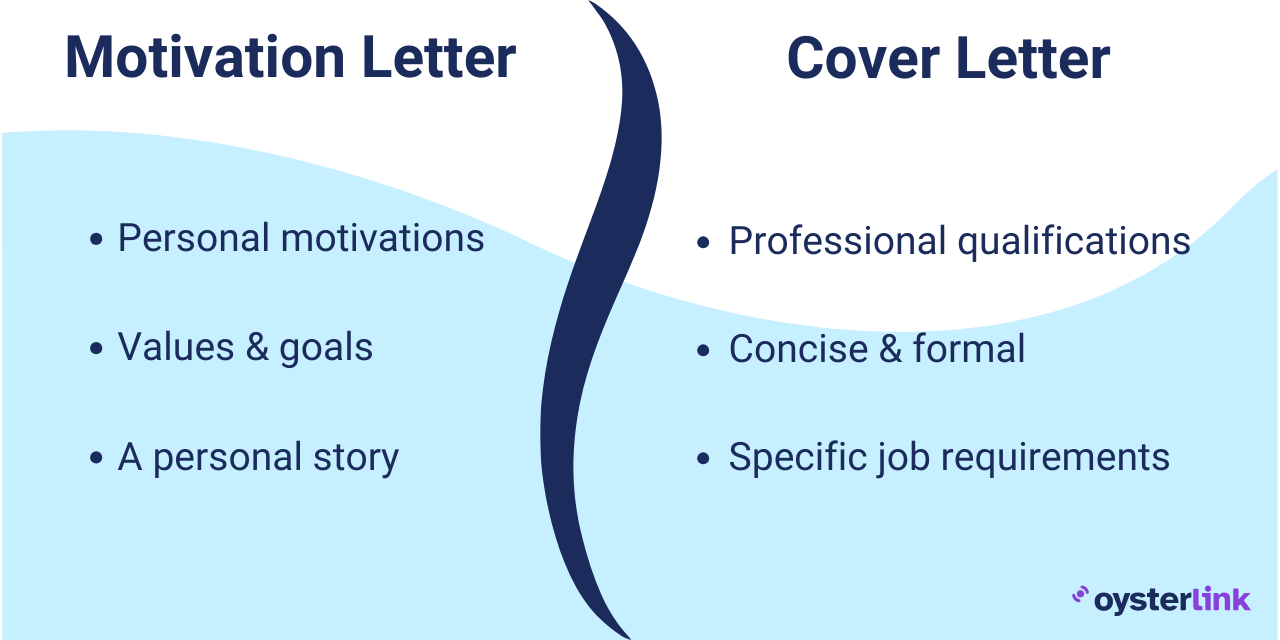
Motivation Letter:
- Focus on personal motivations
- Explores values and goals
- Provides a personal story
Cover Letter:
- Highlights professional qualifications
- Concise and formal
- Addresses specific job requirements
How to Write a Motivational Letter
Writing motivational letters that leave a positive impression should be well structured. This involves knowing what to include and what not to include in it.
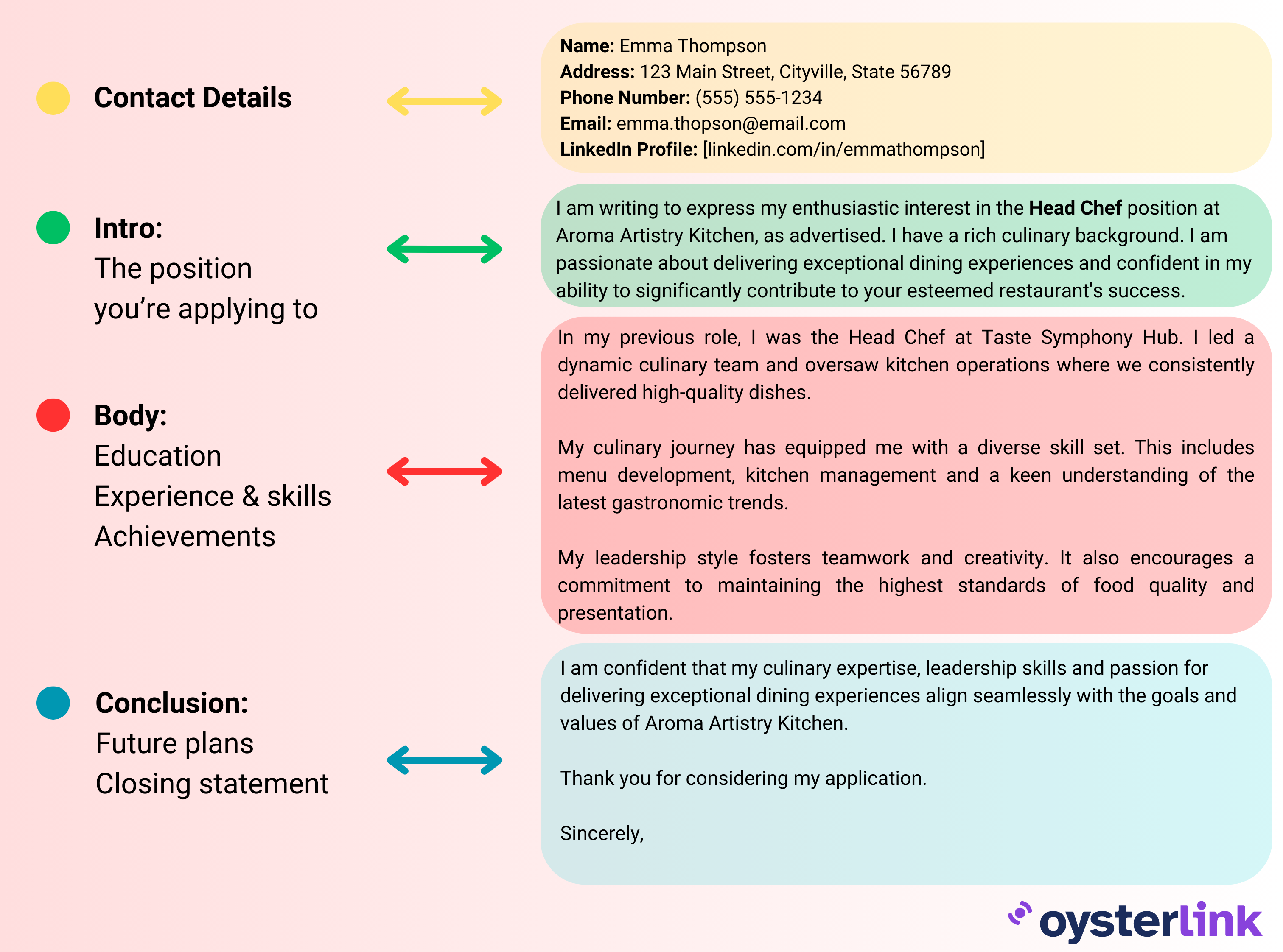
Let’s break down this process to reveal its essential elements:
- Contact details
Introduction
1. contact details.
In this section, you will want to include the following information:
- Academic degree (if applicable)
- Telephone number
- Email address
- Links to relevant social accounts such as your LinkedIn profile
2. Introduction
Begin with a professional greeting and clearly state the purpose of your letter.
It’s best if you know the exact contact person/hiring manager you are talking to and address them by their name right from the start. This shows you’ve done your research and helps you establish a more personalized connection.
In essence, your introduction should answer the following questions:
- What position are you applying for?
- What fuels your interest in joining the team for this job?
- What are you bringing to the organization (your skills and qualities)?
- Why are you the right person for the job?
Use clear, concise language and focus on essential details only.
The body of motivation letters is an extension of your introduction. It usually consists of two or three paragraphs.
The paragraphs convey your enthusiasm for the job and highlight your qualifications.
Why you want the job:
- Express your genuine interest in the position and the company
- Highlight specific aspects you like about the company, such as its values, mission or work culture
- Explain how the job aligns with your career goals and plans
What you can do:
- Showcase your skills and qualifications relevant to the job
- Provide real-life examples of past experiences and achievements
- Use metrics or specific details to add credibility to your statements
Passion and value proposition:
- Convey your passion for the role and the industry
- Discuss how your unique qualities and values align with the company’s mission
- Reinforce your commitment to contributing to the success and growth of the company
Remember to be concise, factual and persuasive. Use clear examples to illustrate your points and show why you are the perfect candidate for the job.
4. Conclusion
In the conclusion of your motivation letter, you want to summarize your key points. This is where you voice your gratitude and leave a positive final impression.
Include the following:
- Briefly recap why you are excited about the job and how it aligns with your career goals
- Thank the reader for considering your application
- Express appreciation for the chance to be part of the selection process
- Reaffirm your excitement about the opportunity and the prospect of contributing to the company’s success
- Politely invite the reader to contact you for further discussion or clarification
- Use a formal closing salutation such as “Sincerely” or “Best Regards”
- Sign off with your full name
Remember to keep this section brief and positive, leaving the reader with a favorable impression of your candidacy.
What Not to Include in Your Motivational Letter
When writing a motivation letter, there are common mistakes you should avoid.
Try to resist the urge to emphasize your weaknesses. While honesty is a valuable trait to have, the motivation letter is the opportunity to showcase your strengths.
Keep your language straightforward and concise. Avoid using fluff words or overly elaborate sentences.
Keep away from statements like “I feel extremely passionate.” Instead, mention a specific event or project you have been a part of. This showcases the genuine depth of your enthusiasm for a subject or field.
Apply the “ So what? ” rule. Ask yourself, ‘ So what does this add to my candidacy?’ If the information doesn’t directly strengthen your case or highlight relevant skills, consider excluding it.
What is the Best Format of a Motivational Letter?
The best motivation letter is formatted in a professional manner. It should be well-organized and tailored to the specific job or program.
Here is a recommended motivation letter template you should follow:
The header is reserved for your personal info, including:
- Your Address (Street, City, State, Zip Code)
- Email Address
- Phone Number
- Links to your relevant social accounts
Don’t forget to include the correct date following the Month-Day-Year US format :
- “January 15, 2024”
Recipient’s Information
Include the recipient’s relevant information, such as:
- Recipient’s Name
- Recipient’s Title (if applicable)
- Company Name (if applicable)
Start with a formal greeting, such as:
- “Dear [Mr./Ms.] [Last Name],” “Esteemed [Mr./Ms.] [Last Name],”
Here’s what you should write in your motivation letter intro:
- The position or program you are applying for
- A brief expression of your enthusiasm for the opportunity
In the body part of your motivation letter, include the following:
- Explain why you are interested in the position or program.
- Emphasize your genuine passion and connection.
- Highlight relevant skills, experiences and achievements.
- Show how your values and goals align with those of the company or program.
The conclusion is where you should briefly summarize the whole purpose of your motivation letter. Here’s what to do:
- Summarize your main points
- Express gratitude for the opportunity
- Use a closing phrase such as “Sincerely” or “Thank you”
- Sign your full name at the bottom
It is also important how your motivation letter looks at first glance. So, pay attention to the following features:
- Consistency: Maintain a consistent font and formatting throughout the letter
- Length: Keep it concise, ideally one page
- Structure: Divide the text into smaller blocks for better readability
4 Motivation Letter Examples
We will provide four examples to guide you through your application process. This will help you look at the motivation letter as a full picture.
1. An Example of a Motivation Letter for a University
Let’s say you need to write a motivation letter to apply for the University of Environmental Science, EcoSphere.
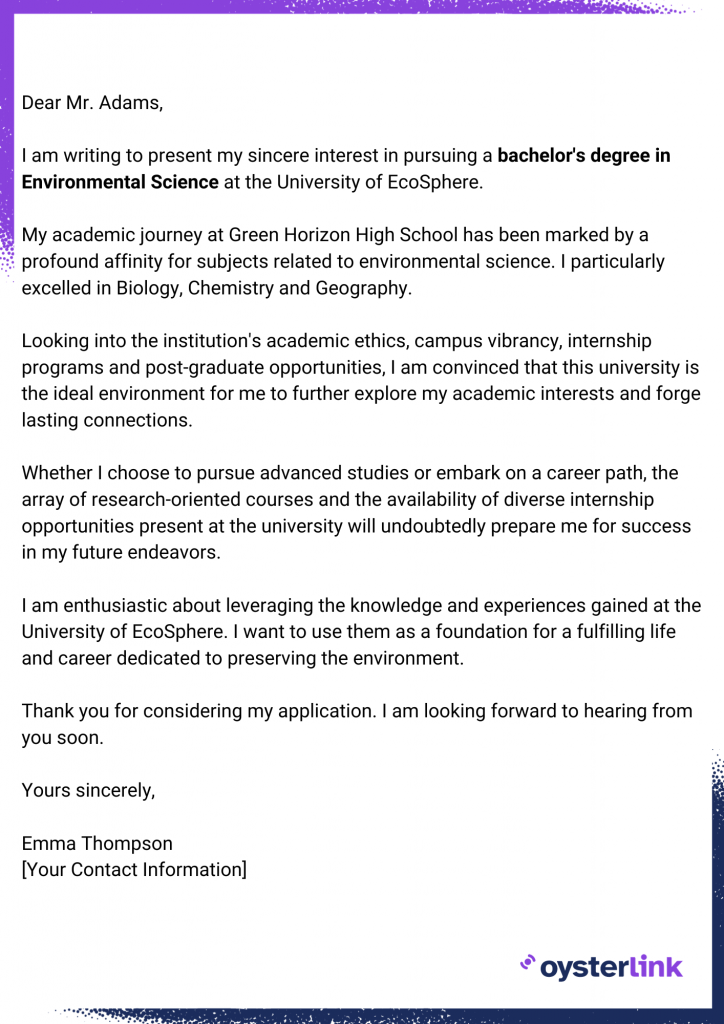
2. An Example of a Motivation Letter for a Scholarship
A motivation letter example when applying for a scholarship should look similar to this.
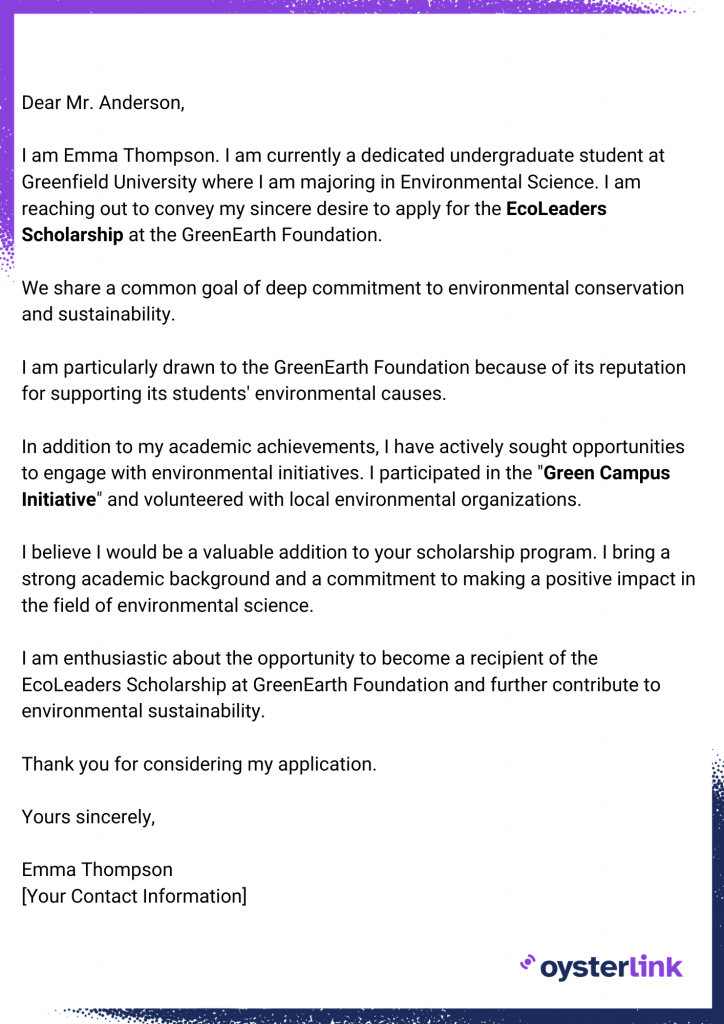
3. An Example of a Motivation Letter for an Internship
If applying for an internship, follow this sample motivation letter structure.
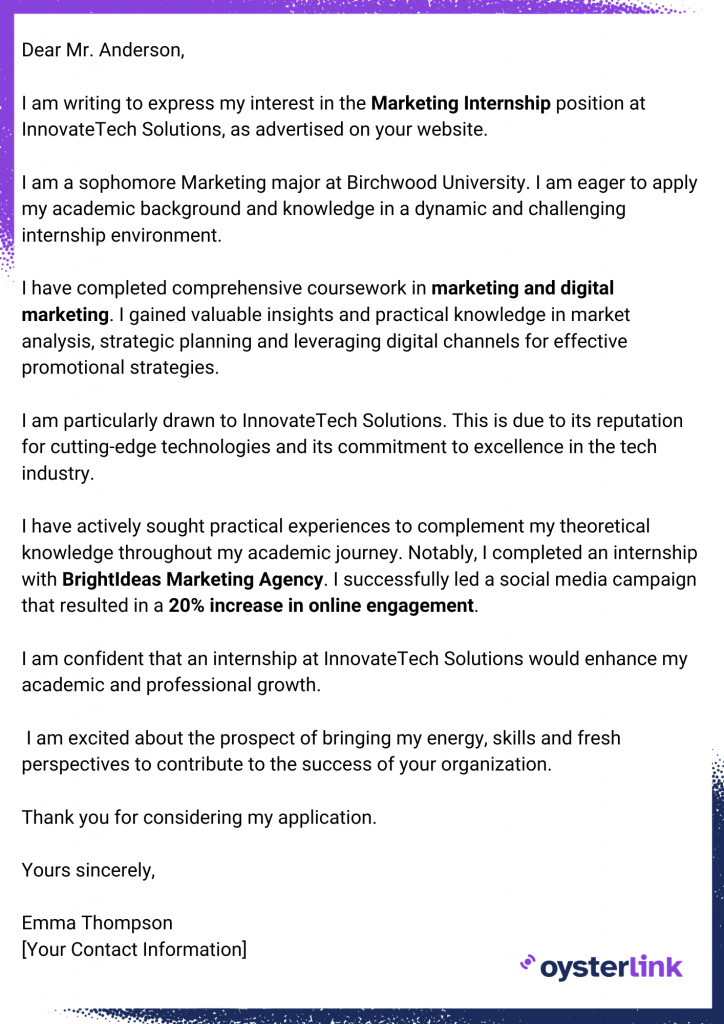
4. An Example of a Motivation Letter for a Job Application
Here is an example of a motivation letter you can use as a guide when applying for a, let’s say, restaurant job .
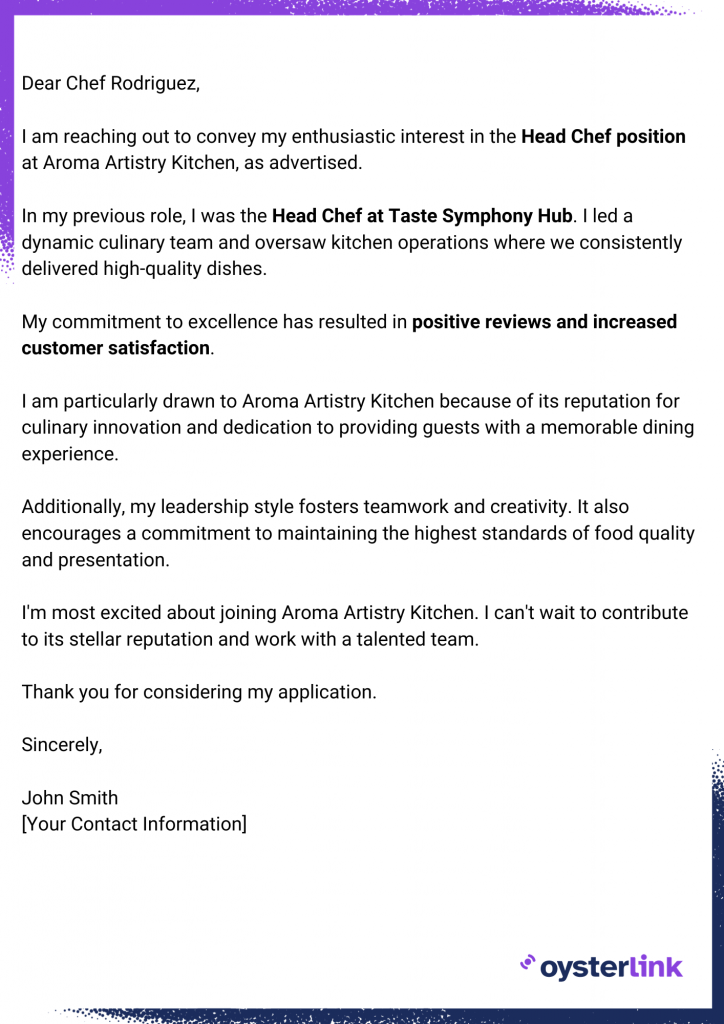
Key Takeaways
When you write a motivation letter, consider its purpose: revealing your personality and traits. Structure your motivation letters so they include your contact details, an introduction a body and a conclusion.
In the contact details section, provide essential information. Include your name, academic degree, address, phone number, email, and relevant social links. Start the introduction with a professional greeting. State your purpose and answer key questions briefly.
The body is an extension of your introduction. Your cover letter should consist of paragraphs expressing your genuine interest in the job. Showcase your skills and convey your passion and unique value proposition. Be concise, factual and persuasive.
Conclude your motivation letters by summarizing key points. Express gratitude and leave a positive final impression. Avoid emphasizing weaknesses, use straightforward language, and be specific about your passion.
For the format, ensure it is professional, well-organized and tailored to the specific job or academic program you’re applying for.
Keep the letter concise, ideally one page and maintain a consistent font and formatting throughout.
Frequently Asked Questions
Here are the answers to some of the most frequently asked questions about writing a motivation letter.
What is the primary purpose of a motivational letter.
The motivational letter serves as a personalized narrative, allowing you to articulate not only your professional qualifications but also the underlying motivations and passions that drive your interest in a particular opportunity.
It goes beyond a traditional resume by providing insight into your character, values and unique attributes.
This document showcases not just what you can do, but also why you are genuinely enthusiastic and well-suited for the specific role, academic program or scholarship you are applying for.
How to structure the introduction of the motivation letters?
When structuring the introduction of your motivational letter, commence with a formal and professional salutation, addressing the recipient appropriately.
Following this, concisely articulate the primary purpose of your letter, explicitly stating why you are reaching out.
It is crucial to immediately establish clarity by offering succinct responses to fundamental questions, such as specifying the position, program or opportunity you are applying for.
Next, state your motivation for applying and briefly outline the unique qualities and qualifications that make you a suitable candidate.
What information should be covered in the body of the motivation letters?
In the body of the motivation letter, provide the specifics of your application by expressing authentic enthusiasm for the opportunity. Communicate your genuine interest by highlighting aspects of the job, academic program or scholarship that resonate with your career goals or academic pursuits.
Substantiate your claims by showcasing concrete examples of your skills and qualifications, providing tangible evidence of your capabilities. Emphasize not only what you can do but also how your unique background, experiences and perspective contribute to your value proposition.
This section serves as the core of your letter, painting a comprehensive picture of why you are the ideal candidate or scholar for the position or program in question.
How long should a motivation letter be?
A good motivation letter should typically be concise, and ideally limited to one page. Keeping it succinct ensures that the reader can quickly grasp the key points without being overwhelmed by excessive information.
Is the motivation letter the same as the cover letter?
No. A cover letter is a formal document submitted alongside a resume or CV during a job application. It serves as an introduction to the applicant and complements the details provided in the resume.
The cover letter typically includes information about the applicant’s qualifications, skills and experiences relevant to the job. In contrast, a motivation letter is often used in academic or international contexts.
It delves into personal motivations, passions, and goals related to the opportunity.
How can you effectively address a surface-level experience in your motivation letter?
In your motivation letter, consider highlighting your enthusiasm for learning. Include your transferable skills and relevant qualities. They make you a strong candidate despite limited formal experience.
Emphasize your eagerness to contribute and willingness to undergo training. Also, mention any related achievements or experiences that showcase your potential and dedication.
How to conclude your motivational letter effectively?
In conclusion, summarize key qualifications and motivations to reinforce your candidacy. Express gratitude for the opportunity, and reaffirm your excitement about contributing.
Conclude with a formal closing salutation, such as “ Sincerely ” or “ Best Regards ,” followed by your full name, maintaining professionalism and leaving a positive and open-ended impression.
You May Also Like


IMAGES
VIDEO
COMMENTS
25 Best Motivation Letter Example Template Body Paragraphs. Here are 25 sample body paragraphs to plug into the template to create your own letter for that potential job at your dream company. 1. What drew me to [Company Name] was your company vision, [company vision/slogan]. I have demonstrated these values through my work at [Company Name] by ...
3. Expand your outline for your body. Expand the points in your outline to form your motivation letter's body. Take a new paragraph for every new topic. Remember, your motivation letter aims to convince your recipient of your value, so use compelling facts to be persuasive. 4. Conclude your motivation letter.
Convey Your Ambitions #8. Don't Lie #9. Use a Motivational Letter Template How to Structure a Motivational Letter #1. Contact Details #2. Introduction #3. Body #4. Conclusion How to Format a Motivational Letter Motivational Letter Example Key Takeaways. You're about to apply for the job opportunity of your dreams.
Use a professional letter font and set it to 12 pt size. Set your letter spacing to 1" on all sides of the page. Choose a good letter layout to convey your professionalism. Make sure you create a professional letter file title so that recruiters can find your motivation letter right away.
After you write a good opening statement, continue describing your motivations for applying in 2-3 more paragraphs. And consider adding a bulleted list to make your motivation letter easier to read. 3. Close strong. End your letter of motivation with a paragraph that: thanks the reader for going through your letter.
Start the outline by listing all the points you need to cover. Structure the letter into three sections: an introduction, a body, and a conclusion. Write the content. Fill in the details for each point. Keep the letter positive by taking about your abilities and strengths.
1. Start With a Motivation Letter Header. Addressing a motivation letter is exactly the same as creating a header for a cover letter. Take a look at this example: Addressing the Letter of Motivation—Example Right Example. Jane Kelly. High-School Graduate. 506 5th St. La Porte, IN 46350, USA. 574-205-9169. [email protected]. 07.20.2023. Ms ...
The words that you choose for the body of your motivation letter will frame the emotional narrative of your interview. Be true to yourself and the right kinds of opportunities will be sure to come your way. You will struggle if you try to be someone else. Hiring managers can sense fake candidates.
A motivation letter is a one-page document candidates write and submit to highlight their passion for the opportunity.. You can write a motivation letter for a university educational program, internship, non-profit organization, or volunteering movement.. The best way to format a motivation letter is to use a business letter format.. Every motivation letter needs to have a catchy opening, an ...
When applying for a job or a university program, the motivation letter is your opportunity to make a great first impression. It is your chance to showcase your skills, achievements, and personality to the employer or admission committee. Overview of Motivation Letter A motivation letter, also called a cover letter, is a formal letter that accompanies your resume or application. It is usually ...
Date: Write the full date, like "April 6, 2023.". Who you're writing to: Write the person's title, name, and address. Make sure it's all correct. Greeting: Start with "Dear" and the person's name or title, like "Dear Mr. Smith.". Use a colon after. What to say: Split your letter into short parts.
Sign off your letter of motivation using your full name. Write 'Yours sincerely' if your motivational letter was addressed to a named person and 'Yours faithfully' if it wasn't, i.e. if you started off with 'Dear Hiring Manager'. Throw in a professional element with a digital copy of your handwritten signature.
Delve into the body paragraphs. This is where you cover the reason you're applying and why you'd be an asset to the program. Like with an essay, this should be two to three paragraphs, depending on length. Don't be afraid to go over the length limit the first time - you can always cut back later.
a Winning Motivation Letter in 2024. Stephen Greet April 13, 2024. Scholarships, degrees, volunteer roles, internships, and jobs share a key requirement: motivation. No matter if you're applying for a research position or hoping to score a scholarship, the person you're writing to wants to know that you're motivated, and beyond that, what ...
Font - Top 10 best fonts for a letter of motivation are: Arial, Cambria, Calibri, Didot, Garamond, Georgia, Helvetica, Times New Roman, Trebuchet MS, and Veranda. Spacing - The standard letter spacing is 1" on all sides of the page, but you can adjust it accordingly based on the space.
Be sure to express gratitude for their time and consideration at the conclusion of your motivational letter. Use a formal ending salutation, such as "Sincerely," "Best regards," or "Thank you for your consideration.". Stay away from overused words and phrases like "Yours," "Cheers," and "Take care.".
In a motivation letter, it's important to include the following components: A concise introduction with a clear purpose statement. An explanation of your interest in the role or program. Your relevant qualifications, skills, and experiences. Examples of how you can contribute or make an impact.
Motivational letter for a job application: closing. My thanks to you for reviewing my application. Please don't hesitate to contact me on the number above at any time that's convenient to you so we can discuss this opportunity in more detail. 6. Use the correct sign-off in your motivation letter for a job.
Step 5: Proofread your letter. The fifth and final step of your motivation letter is to proofread it. Making sure that your letter is flawless ensures that you appear professional and competent. Correct spelling and grammar mistakes. Weed out any awkward sentences.
But if you prefer to get some guidance, have a look at our motivational letter templates below. Example 1: Motivation Letter for a Masters of Science Degree (MSc) Dear sir /Madam, My name is [name] and most recently I have been working as a [job title] at [company name]. I hold a B.Sc degree in [subject] from [university name].
The best motivation letter is formatted in a professional manner. It should be well-organized and tailored to the specific job or program. ... A motivation letter example when applying for a scholarship should look similar to this. 3. An Example of a Motivation Letter for an Internship.
First, address the letter to a person if you know who will read it. Otherwise, just start with "Dear Sir or Madam". When starting your motivation letter make sure to grab the reader's attention from the opening paragraph and tell them exactly what they need to know from the very beginning.
3. Expand on key topics. Expand on the key bullet points included in your outline to craft the body of your motivation letter. You can create a new paragraph for each topic to structure this section. Remember, your motivation letter aims to convince your recipient of your value, so use compelling facts to be persuasive.